
- Find A School
- Certifications
- North U Sail Trim
- Inside Sailing with Peter Isler
- Docking Made Easy
- Study Quizzes
- Bite-sized Lessons
- Fun Quizzes
- Sailing Challenge
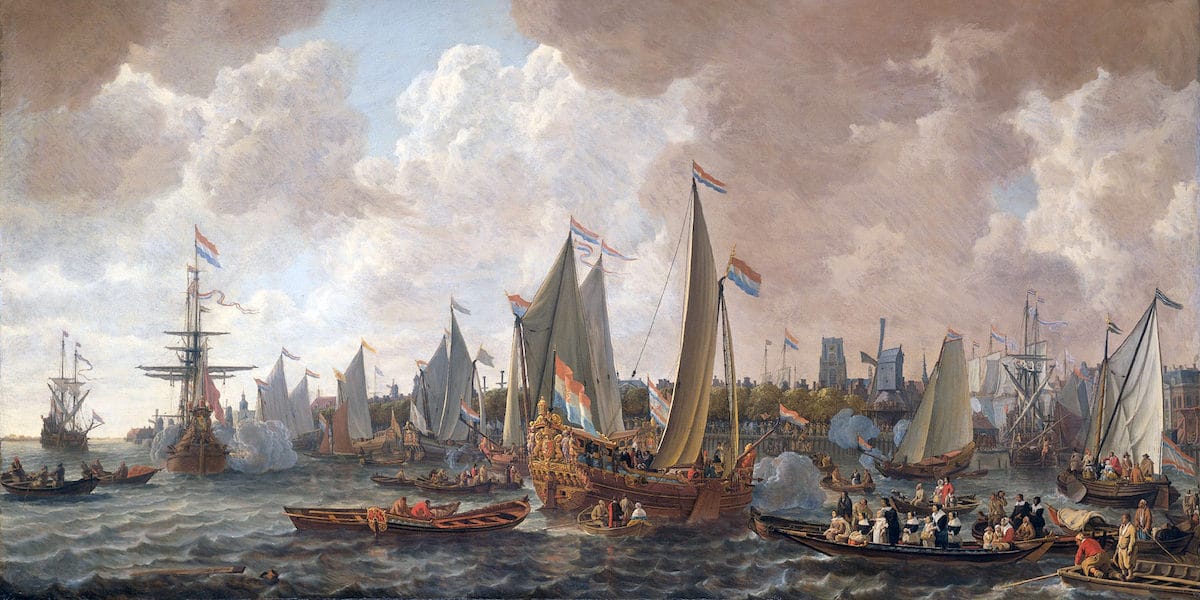

History of the Yacht
By: American Sailing Sailing History
When does a boat become a yacht? One answer has always been, you can tell a yacht when you see one. But, It really has nothing to do with size of the boat, weight of the boat, its style, sleeping quarters, heads, tillers, or a wheel. A yacht is a boat that was designed for the express pleasure of its owner.
The yacht is an invention of the 14th century Dutch. The Dutch used small, fast boats for chasing smugglers, pirates and criminals. Rich ship owners and merchants began using these small “ jaghts ” to sail out to celebrate their returning merchant ships. It quickly became chic to use these “ jaghts ” to take friends out just for pleasure.

“ Mary ” was presented to King Charles II by the Dutch in 1660.
Charles II of England spent 10 years in exile in Holland before he was returned to the English throne in 1660. His return to the throne was celebrated by the city of Amsterdam, presenting him with a luxurious 60’ yacht including a crew of 20. Her name was Mary. He took great pleasure in sailing her up and down the Thames. He studied navigation and even naval architecture and he built approximately 20 yachts during his lifetime. It can be said that he was the world’s first yachtsman. His enthusiasm for yachting was contagious and his brother James, Duke of York, joined him and also became an avid yachtsman as well.
As always when there are two sailboats on the water a race ensues. Soon the first organized regatta was planned as a 40-mile race on the Thames. It took place in 1661 between Katherine , Charles’s newly constructed yacht and Anne , the Duke of York’s new yacht with Charles himself at the helm Katherine won and a new sport was born.
Yachting stayed the Sport of Kings for over a century, but by the 1800s yachting had grown to included participants of more than just the crown heads of Europe. The worlds wealthiest had joined in. Yacht Clubs were forming. The first yacht club in the world, called the Cork Water Club , was established in Ireland in 1720, followed the Lough Ree Yacht Club in 1770 (again in Ireland), and the Starcross Yacht Club in 1772 in England.

Cowes Castle became the headquarters of the Royal Yacht Squadron around 1858.
Probably the most famous of all the English yacht clubs the The Royal Yacht Squadron was founded on June 1, 1815 in the Thatched House Tavern in St James’s, London as The Yacht Club by 42 gentlemen interested in yachting.
Across the pond the New York Yacht Club (NYYC) was started on July 30, 1844 when John Cox Stevens invited eight friends to his yacht Gimcrack , anchored in New York Harbor. They formed a syndicate to build a yacht with the intention of taking her to England and making some money competing in yachting regattas and match races. They choose to build a Pilot style Schooner to represent the club; at the time there was no faster design!
Pilot Schooners would lie at anchor in the inner harbor of New York City and wait for the behmoth square rigged Clippers carrying goods between America and Europe. The Pilot Boats purpose was to guide the huge square riggers that would appear at the entrance to New York Harbor’s Verazno Straights, to a berth in the City. The Schooners had to be fast to make a living. First one to the cargo ship got the job second got nothing.
The syndicate contracted with master schooner designer George Steers for a 101 ft (30.78 m) schooner which was christened America and launched on the 3 of May 1851. America crossed the Atlantic on her own bottom that year and challenged all of England’s fastest yachts to a match race. No yachts were willing to race her. Finally, America joined a free-for-all on Friday, August 22, around the Isle of Wight, racing against 15 yachts of the Royal Yacht Squadron in the club’s annual 53-nautical-mile (98 km) race around the Isle of Wight. Finishing 8 minutes ahead of its closest rival. America had won the Royal Yacht Squadron’s “ Hundred Guinea Cup “, later called the America’s Cup in honor of the yacht that won it.

The Yacht America
Watching the race was Queen Victoria, who supposedly inquired, “ Which is first? ” Told it was America , she asked, “ Which is second? ” “ Ah, Your Majesty, there is no second, ” was the reply. Or so the story goes. The NYYC defended that trophy from 1870-1983. This has been described by journalists as “ the longest winning streak in sports “.
Related Posts:

- Learn To Sail
- Mobile Apps
- Online Courses
- Upcoming Courses
- Sailor Resources
- ASA Log Book
- Bite Sized Lessons
- Knots Made Easy
- Catamaran Challenge
- Sailing Vacations
- Sailing Cruises
- Charter Resources
- International Proficiency Certificate
- Find A Charter
- All Articles
- Sailing Tips
- Sailing Terms
- Destinations
- Environmental
- Initiatives
- Instructor Resources
- Become An Instructor
- Become An ASA School
- Member / Instructor Login
- Affiliate Login
The Evolution of Boats Over Time: A Journey Through History
Introduction to the topic.
“From the humble rafts of ancient civilizations to the magnificent ships that sail the oceans today, boats have been an integral part of human existence, shaping our exploration, trade, and cultural development. Imagine a world without boats, and you’ll find a world where boundaries remain unexplored and opportunities unrealized.”
Boats have played a crucial role in the development of human civilization since time immemorial. They have served as vehicles for transportation, tools for exploration, and platforms for cultural exchange. The history of boats spans thousands of years, reflecting our innate curiosity and desire to conquer the vast expanses of water that cover our planet.
This article will take you on a fascinating journey through the evolution of boats, highlighting key milestones and their impact on various aspects of human life. From the early watercraft used by ancient civilizations to the advanced vessels of the modern era, we will explore how boats have shaped our history, facilitated trade and communication, and provided the means for great discoveries and adventures.
The Origins of Boats
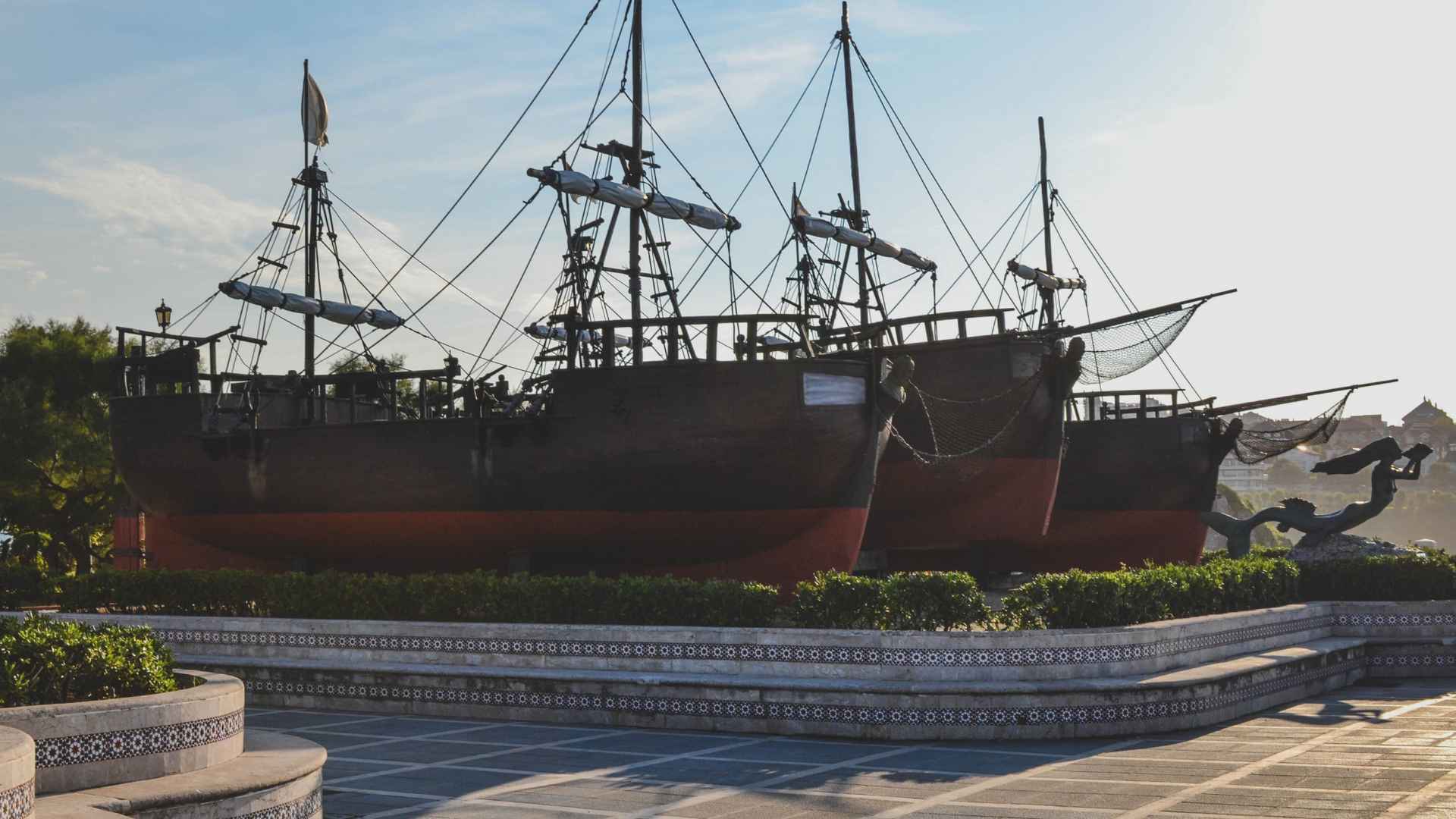
Boats, in their simplest form, can be traced back to prehistoric times when humans first recognized the potential of floating objects. These early watercrafts were rudimentary, often crafted from hollowed-out logs or bundles of reeds.
Prehistoric watercraft: primitive boats made from hollowed-out logs or bundles of reeds.
Prehistoric watercrafts serve as a testament to human ingenuity and resourcefulness in utilizing the materials available to them. These early examples of primitive boats were often constructed from hollowed-out logs or bundles of reeds, reflecting the fundamental desire of our ancestors to explore bodies of water and overcome the challenges they presented.
1. Hollowed-out logs
One of the earliest forms of watercraft can be traced back to the use of hollowed-out logs. In this method, a large tree trunk was carefully hollowed, either by burning or using stone tools, to create a boat-like structure. This simple yet effective design provided buoyancy and stability, allowing early humans to venture into lakes, rivers, and other bodies of water.
Hollowed-out log boats were primarily used for fishing and transportation purposes. They enabled humans to access resources that were otherwise difficult to reach, expanding their territories and facilitating trade between different communities. These early boats laid the foundation for future advancements in watercraft design.
2. Bundles of reeds
In areas where logs were scarce, such as marshlands or regions with abundant reed growth, our ancestors developed alternative techniques using bundles of reeds. These boats, often referred to as coracles or reed boats, were created by tying bundles of reeds together to form a buoyant structure.
The construction of reed boats varied across different regions and cultures. For example, in ancient Mesopotamia, bundles of reeds were lashed together to create guffas, lightweight boats used for river transportation. Similarly, the ancient Egyptians used bundled papyrus reeds to construct small boats known as skiffs or “papyrus boats.”
Reed boats were particularly suited for navigating shallow waters, such as marshes or calm river systems. They provided early humans with the means to fish, hunt waterfowl, and gather resources from wetland environments. These boats were often lightweight, portable, and easily repairable, making them practical for the needs of early societies.
Both hollowed-out log boats and reed boats demonstrated the initial steps humans took in harnessing the power of water transportation. These primitive watercrafts allowed our ancestors to explore, trade, and interact with their surroundings in ways that were previously inaccessible. As civilizations developed and technology progressed, these early examples paved the way for more sophisticated boat designs and propelled humanity further along the path of maritime exploration and discovery.
Early river civilizations: development of boats by ancient river civilizations
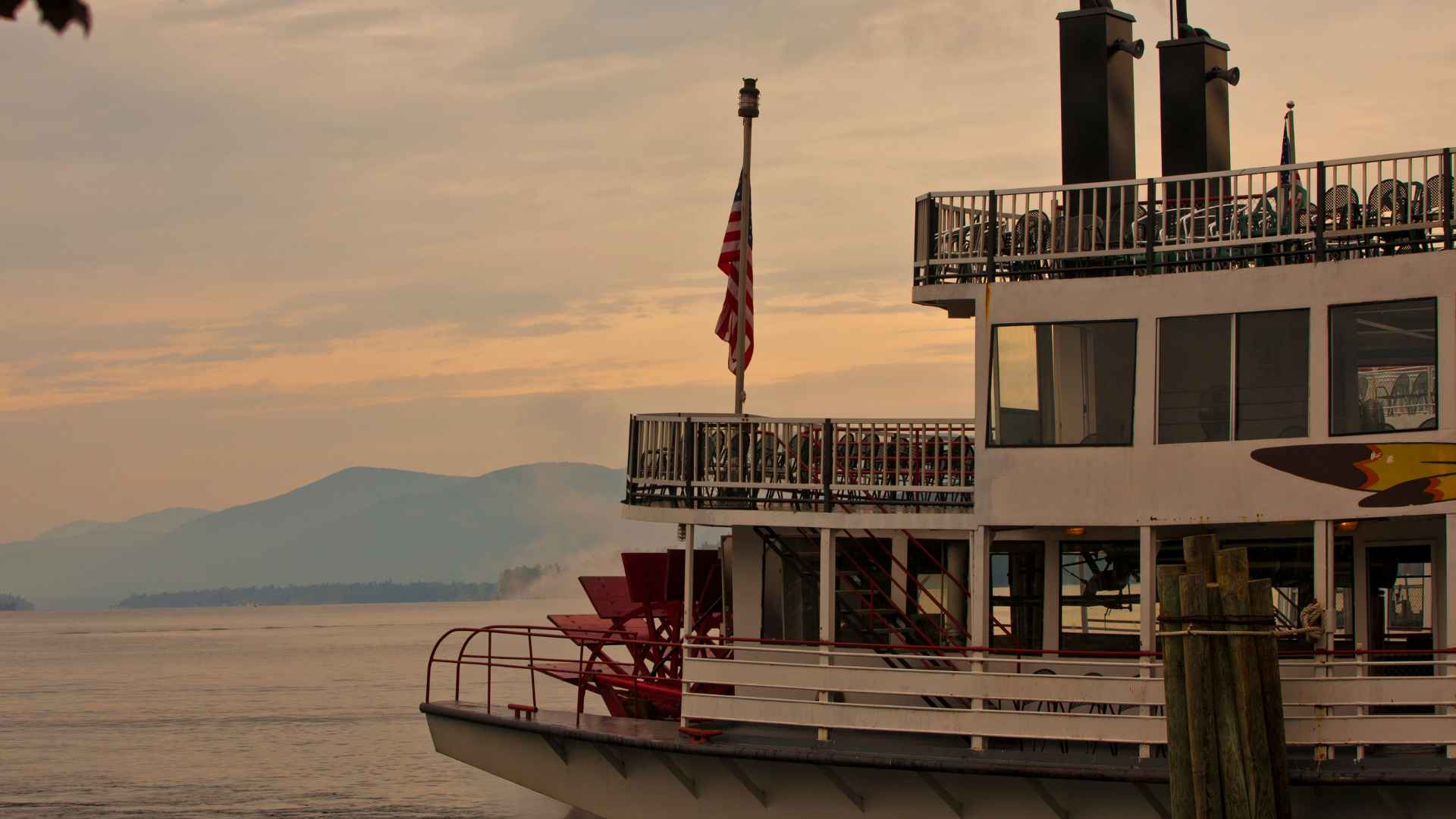
The development of boats by ancient river civilizations, such as the Egyptians and Mesopotamians, marked a significant advancement in maritime technology and played a crucial role in shaping their societies. These civilizations recognized the value of rivers as lifelines for transportation, trade, and cultural exchange, leading to remarkable innovations in boat design and construction.
1. Ancient Egypt
The Egyptians, with their close proximity to the Nile River, developed an intricate understanding of boat construction and navigation. Boats played a vital role in the economic, religious, and cultural life of ancient Egypt. The Egyptians built various types of boats tailored to different purposes. The most famous of these were the “solar boats” associated with religious rituals and the afterlife.
These boats were built using planks and were often buried alongside pharaohs in their tombs. The Khufu Solar Boat, discovered near the Great Pyramid of Giza, is a remarkable example of ancient Egyptian boat craftsmanship. For trade and transportation, the Egyptians used riverboats known as “kedjet,” which were constructed using wooden planks and equipped with sails.
These boats allowed the Egyptians to navigate the Nile River, facilitating the movement of goods, people, and military expeditions between different regions of their empire. They were also used in fishing and hunting.
2. Mesopotamia
The ancient civilizations of Mesopotamia, located between the Tigris and Euphrates rivers, also made significant contributions to boat development. The availability of these rivers fostered the growth of advanced irrigation systems and facilitated the transportation of goods. In Mesopotamia, boats made from bundles of reeds tied together, called “guffas,” were commonly used.
These lightweight vessels were well-suited for navigating the shallow waters of the Euphrates and Tigris rivers. Guffas allowed the Mesopotamians to transport people, goods, and livestock, connecting cities and fostering trade networks.
The Mesopotamians also developed larger sailing ships for long-distance trade in the Persian Gulf and beyond. These ships, known as “biremes” or “triremes,” had multiple rows of oars and were capable of carrying substantial cargo. They played a crucial role in expanding Mesopotamian influence and facilitating cultural exchange with other civilizations in the region.
The boat designs of both ancient Egypt and Mesopotamia were products of their respective environments, resources, and societal needs. These river civilizations relied on boats for transportation, trade, agriculture, and defense, contributing to the development of sophisticated shipbuilding techniques and navigational knowledge.
The advancements made by these ancient river civilizations laid the foundation for future maritime exploration and trade. The knowledge and technologies developed during this period would be further refined and disseminated to other cultures, shaping the evolution of boats in the centuries to come.
Navigating the open seas: advancements in boat design and construction that allowed early seafaring civilizations to explore and trade across vast distances.
The advancements in boat design and construction during the era of early seafaring civilizations revolutionized their ability to navigate the open seas and undertake long-distance exploration and trade. These advancements opened up new horizons, connecting distant lands and cultures and paving the way for significant historical developments.
1. Phoenicians
The Phoenicians, a maritime civilization flourishing in the eastern Mediterranean from the 12th to the 6th centuries BCE, played a crucial role in pushing the boundaries of seafaring. They were renowned for their shipbuilding skills and navigation prowess, which allowed them to explore and establish extensive trade networks.
Phoenician shipbuilders developed sturdy wooden ships known as “galleys” or “biremes.” These vessels had multiple rows of oars and were propelled by both oarsmen and sails. They were constructed using a combination of wooden planks and strong ropes, demonstrating a sophisticated understanding of shipbuilding techniques.
The Phoenicians utilized their advanced boats to navigate the Mediterranean Sea and establish trade routes connecting different civilizations. They traded goods such as textiles, metalwork, and agricultural products, contributing to the cultural exchange and economic prosperity of the regions they visited.
2. Polynesians
In the Pacific Ocean, the Polynesians demonstrated remarkable achievements in seafaring and boat design. They developed exceptional double-hulled canoes , known as “wa’a,” capable of withstanding long-distance voyages.
Polynesian boat construction incorporated sturdy wooden frames and hulls made from a combination of planks and natural fibers. These canoes were equipped with sails made from woven palm leaves or other locally available materials. The design of the double hulls provided stability and increased carrying capacity, enabling the Polynesians to undertake extended journeys across vast expanses of the Pacific.
Through their exceptional navigation techniques, which relied on celestial observations, knowledge of ocean currents, and bird migrations, the Polynesians explored and settled numerous islands across the Pacific. This seafaring culture played a vital role in the dispersal of people, trade, and the exchange of ideas throughout the Pacific region.
3. Ancient Greeks
The ancient Greeks also made notable advancements in ship design, particularly during the Classical period. They developed triremes, ancient warships propelled by multiple rows of oars. These vessels had a sleek design, with a ram at the prow for naval warfare.
Greek shipbuilders refined their construction techniques, employing a combination of wooden planks, internal bracing, and strategic use of sails. These innovations allowed Greek ships to achieve impressive speeds and manoeuvrability, enhancing their naval dominance in the Mediterranean and facilitating trade and colonization efforts.
The advancements in boat design and construction during the era of early seafaring civilizations transformed the possibilities of maritime exploration and trade. These advancements led to the establishment of trade routes, cultural exchanges, and the dissemination of knowledge across vast distances, shaping the course of history and laying the foundation for future maritime developments.
Innovations and Ancient Maritime Cultures:
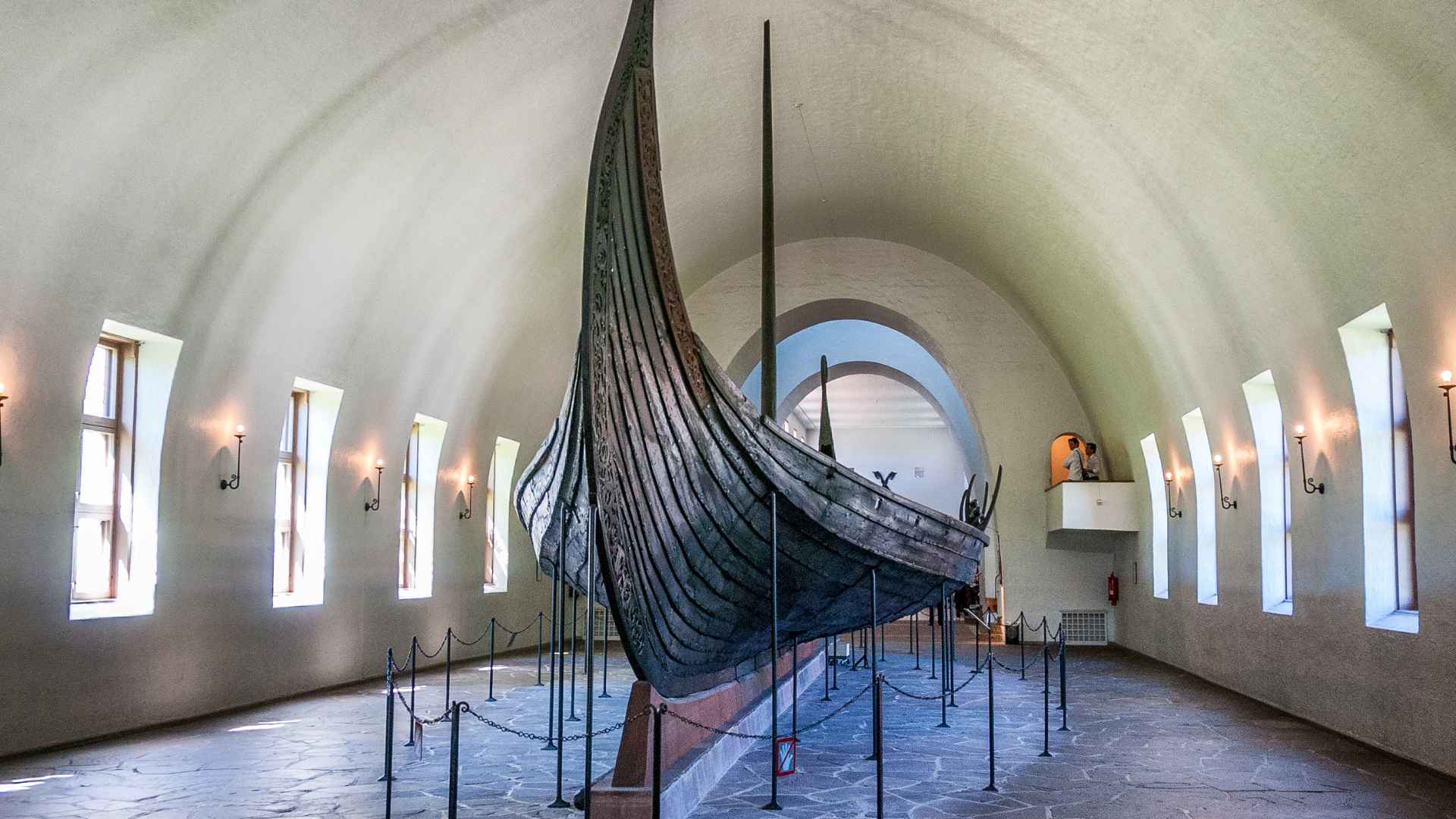
The Phoenicians: the maritime prowess of the Phoenicians and their role in spreading boat-building knowledge.
The Phoenicians were renowned for their maritime prowess and played a significant role in spreading boat-building knowledge throughout the ancient world. Hailing from the eastern Mediterranean, their seafaring skills and trade networks extended across the region.
Phoenician shipbuilders excelled in constructing sturdy and seaworthy vessels. They developed advanced techniques, including the use of mortise and tenon joints and wooden pegs, to build strong hulls. Their ships, such as the biremes and triremes, were propelled by both oars and sails, enabling them to navigate long distances efficiently.
The Phoenicians established extensive trade routes, reaching as far as Britain in the west and the Red Sea in the east. Through their maritime activities, they disseminated boat-building knowledge and techniques to other civilizations they encountered. This knowledge exchange contributed to the advancement of boat design and construction in the ancient world.
Greek and Roman vessels: technological advancements in boat design during the classical era, including triremes and galleys.
During the classical era, both the Greeks and Romans made significant technological advancements in boat design. The Greeks, in particular, developed renowned naval vessels such as triremes and galleys.
Triremes were warships propelled by three banks of oars on each side, giving them exceptional speed and maneuverability. These vessels featured a ram on the prow for ramming enemy ships during naval battles. The construction of triremes involved precise woodworking, internal bracing, and careful distribution of weight to ensure optimal performance.
Galleys, used for both warfare and trade, were longer vessels with multiple rows of oars and a large sail. The Romans, inspired by Greek shipbuilding techniques, adopted and further refined the design of galleys. They introduced advancements such as the “corvus,” a boarding bridge with a spike that could be dropped onto enemy ships, enhancing their naval tactics.
The technological advancements in boat design during the classical era revolutionized naval warfare and facilitated long-distance trade. These vessels not only influenced Mediterranean cultures but also inspired later civilizations in their boat-building endeavors.
Viking longships: Iconic longships of the Vikings, which played a crucial role in their explorations and raids.
The Vikings, known for their seafaring and exploration during the Viking Age (8th to 11th centuries CE), employed iconic longships that played a crucial role in their expeditions, raids, and trade activities.
Viking longships were sleek, shallow-drafted vessels with a symmetrical design and a flexible hull. They were propelled by both oars and sails, allowing the Vikings to navigate rivers, coastal waters, and even venture across the open seas. The longships’ shallow draft enabled them to navigate shallow waters and make landfall in areas unreachable by larger vessels.
These ships were not only instrumental in Viking raids but also served as tools for exploration, trade, and colonization. The Viking longships facilitated the exploration and settlement of regions such as Iceland, Greenland, and even parts of North America, leaving a lasting impact on the cultural and historical development of these areas.
The Viking longships showcased remarkable craftsmanship, with overlapping planks, clinker-built construction, and sophisticated rigging systems. They were designed to withstand challenging maritime conditions and provided the Vikings with a versatile and formidable means of transportation and exploration.
The innovations and advancements in boat design by ancient maritime cultures, such as the Phoenicians, Greeks, Romans, and Vikings, left an indelible mark on maritime history. These cultures pushed the boundaries of boat-building techniques, enabling them to navigate vast distances, engage in trade and exploration, and shape the course of human civilization.
Medieval and Renaissance Developments:
Arab dhow ships: influence of arab maritime culture and their development of the dhow ships, known for their lateen sails..
Arab maritime culture made significant contributions to boat design and navigation, particularly through the development of dhow ships. Dhows were sailing vessels characterized by their distinctive lateen sails, which allowed for efficient navigation against the prevailing winds.
Arab sailors and shipbuilders mastered the art of constructing dhows using indigenous materials such as teak wood. The hulls were built with a sewn plank technique, where planks were stitched together with coconut fiber or other natural fibers. This flexible construction method made the dhows resilient and capable of navigating shallow waters.
Dhows played a crucial role in Arab trade networks, facilitating maritime commerce across the Indian Ocean and the Red Sea. They were versatile vessels, capable of carrying goods, passengers, and even livestock. The lateen sails of dhows enabled them to navigate both coastal and open waters, making them ideal for long-distance travel and trade.
The influence of Arab maritime culture and the design of dhow ships spread throughout the Indian Ocean, influencing boat construction in regions such as East Africa, India, and Southeast Asia. Even today, the traditional design and sail plan of dhows continue to be used in certain parts of the world.
Chinese treasure ships: impressive fleet of Chinese treasure ships commanded by Admiral Zheng He during the Ming Dynasty.
During the Ming Dynasty in the 15th century, China witnessed a remarkable era of maritime exploration led by Admiral Zheng He. Zheng He commanded an impressive fleet of Chinese treasure ships, known as “baochuan,” which showcased remarkable advancements in shipbuilding for their time.
The treasure ships were colossal in size, with some estimates suggesting they could reach up to 400 feet in length. These massive ships featured multiple masts and were constructed using advanced techniques such as keel compartments for added stability and watertight bulkheads. The fleet was equipped with navigational instruments, advanced rigging systems, and carried a significant cargo capacity.
Zheng He’s treasure ships undertook seven major expeditions, exploring and establishing diplomatic relations with countries throughout Southeast Asia, the Indian Ocean, and even as far as East Africa. The voyages were instrumental in expanding Chinese influence, promoting trade, and fostering cultural exchange.
The treasure ships of Admiral Zheng He demonstrated China’s maritime capabilities and showcased its technological advancements in shipbuilding, navigation, and exploration. However, with the shift in political priorities, China subsequently curtailed its maritime expeditions, and the treasure ship fleet eventually fell into disuse.

European exploration vessels: Advancements in shipbuilding during the Age of Exploration, including caravels and galleons.
During the Age of Exploration, European nations made remarkable advancements in shipbuilding, enabling them to undertake ambitious voyages of discovery and trade.
Caravels were one such development that revolutionized European exploration. Caravels were small, highly maneuverable ships with a combination of square and lateen sails. They were equipped with rudders mounted at the stern, allowing for increased control and maneuverability. Caravels were the preferred vessels for explorers such as Christopher Columbus and Vasco da Gama, enabling them to venture into uncharted waters and reach distant lands.
Galleons were another notable development in European shipbuilding. These large, heavily armed vessels combined the maneuverability of caravels with the firepower of warships. Galleons were equipped with multiple decks and carried an impressive array of cannons, making them formidable ships of war and exploration. They played a pivotal role in European colonial expansion and trade during the 16th and 17th centuries.
The advancements in shipbuilding during the Age of Exploration allowed European nations to undertake ambitious voyages of discovery, colonization, and trade. These vessels facilitated the exploration of new lands, the establishment of global trade networks, and the reshaping of world history.
Overall, the medieval and Renaissance periods witnessed significant developments in boat design and construction, driven by Arab, Chinese, and European maritime cultures. These advancements expanded the possibilities of maritime exploration, trade, and cultural exchange, leaving a lasting impact on the course of human history.
Industrial Revolution and Modern Boats
Steam-powered ships: revolutionary impact of steam-powered ships on transportation, trade, and warfare..
The advent of steam-powered ships during the Industrial Revolution brought about a revolutionary transformation in maritime transportation, trade, and warfare. Steam engines replaced wind and muscle power, allowing vessels to navigate more efficiently and reliably, regardless of wind conditions.
Steam-powered ships, such as paddle steamers and later screw-driven steamships, played a significant role in expanding global trade and transportation networks. They were not reliant on wind patterns, enabling them to travel along predetermined routes with greater speed and reliability. Steamships facilitated the transportation of goods and people across vast distances, connecting continents and fueling economic growth.
Steam-powered naval vessels also transformed warfare at sea. Ironclads, powered by steam engines and equipped with heavy armor and powerful artillery, revolutionized naval warfare during the mid-19th century. These ships rendered traditional wooden sailing vessels obsolete, changing the dynamics of naval conflicts and defense strategies.
The birth of leisure boating: Emergence of recreational boating and the introduction of pleasure craft.
As industrialization progressed and societies experienced greater prosperity, the emergence of leisure boating became possible. The introduction of recreational boating and pleasure craft marked a shift from boats primarily used for utilitarian purposes to vessels designed for enjoyment and leisure activities.
During the 19th century, yachting gained popularity among the wealthy. Elaborate sailboats and yachts were built for pleasure cruising and competitive sailing races. The Royal Yacht Squadron’s establishment in 1815 and the America’s Cup race in 1851 further popularized recreational boating, leading to the development of more sophisticated sailing yachts.
Modern maritime technology: Modern innovations in boat design, materials, and propulsion systems, including fiberglass hulls and outboard engines.
In the modern era, boat design, materials, and propulsion systems have undergone significant advancements, enhancing performance, safety, and efficiency.
Fiberglass, a lightweight and durable material, revolutionized boat construction in the mid-20th century. It replaced traditional wooden hulls, offering increased strength, reduced maintenance, and improved resistance to water damage. Fiberglass hulls allowed for the mass production of boats, making them more accessible to a wider range of enthusiasts.
Outboard engines, introduced in the early 20th century, have become a popular propulsion system for recreational boats. These portable engines mounted on the stern provide flexibility and ease of use. Outboard motors offer increased maneuverability, allowing boats to operate in shallower waters and navigate congested areas more effectively.
Advancements in navigation and communication technology, such as GPS systems and marine electronics, have greatly improved the safety and efficiency of modern boating. These technologies provide accurate positioning, real-time weather updates, and improved communication capabilities, making boating safer and more enjoyable.
In recent years, there has been a growing focus on eco-friendly boat designs and alternative propulsion systems. Electric boats, hybrid engines, and sustainable materials are being explored to reduce the environmental impact of boating and promote sustainable practices.
The Industrial Revolution and modern innovations in boat design, materials, and propulsion have transformed the maritime industry. From steam-powered ships revolutionizing transportation and warfare to the birth of leisure boating and the constant pursuit of technological advancements, boats continue to evolve, adapting to changing societal needs and technological possibilities.
Contemporary Boating Culture

Boating for pleasure and sport: Widespread popularity of recreational boating and the various activities associated with it.
Recreational boating has become a widespread and beloved activity around the world. Boaters take to the water for various purposes, including cruising, water skiing, wakeboarding, fishing, sailing, and simply enjoying the beauty of nature. Boating provides an escape from the daily grind, allowing people to relax, unwind, and connect with friends and family.
Boating has also given rise to a vibrant sports culture. Competitive events such as sailing regattas, powerboat races, fishing tournaments, and water skiing championships attract participants and enthusiasts from all walks of life. These events foster a sense of community, camaraderie, and healthy competition among boating enthusiasts.
Commercial and industrial applications: Role of boats in industries such as fishing, transportation, and offshore exploration.
Boats play a crucial role in various commercial and industrial sectors. Fishing boats are essential for the global fishing industry, supporting the livelihoods of millions of people and providing a vital source of food for populations around the world. Trawlers, longliners, and purse seiners are examples of boats used in commercial fishing, each designed for specific fishing methods and target species.
Transportation by boat remains crucial for the movement of goods and people in many regions. Ferries, cargo ships, and passenger liners facilitate transportation across rivers, lakes, and seas, connecting communities and enabling trade and tourism.
In offshore exploration, specialized vessels such as drilling rigs, supply boats, and research vessels support the oil and gas industry, scientific expeditions, and offshore renewable energy projects. These boats are equipped with advanced technology and capabilities to operate in challenging marine environments.
Environmental concerns and sustainability: Importance of responsible boating practices and efforts to protect marine ecosystems.
As boating continues to thrive, there is a growing recognition of the importance of responsible boating practices and environmental stewardship. Efforts are being made to minimize the impact of boating on marine ecosystems and preserve the health and beauty of our waters.
Boaters are encouraged to follow responsible boating practices, such as proper waste disposal, adherence to speed limits, and respecting protected areas. Education and awareness campaigns promote boater safety, the prevention of pollution, and the conservation of marine life.
Sustainable boating initiatives aim to reduce the environmental footprint of boats. This includes the adoption of eco-friendly technologies, such as electric propulsion systems, hybrid engines, and renewable energy sources. Boat manufacturers are incorporating sustainable materials and implementing eco-friendly manufacturing processes.
Furthermore, conservation organizations and governmental agencies work together to establish marine protected areas, regulate fishing practices, and implement policies to safeguard fragile ecosystems.
By promoting responsible boating practices and supporting sustainable initiatives, boaters and industry stakeholders can contribute to the preservation of marine environments, ensuring that future generations can continue to enjoy the beauty and benefits of our oceans, rivers, and lakes.
In conclusion, contemporary boating culture encompasses recreational pursuits, commercial applications, and a growing emphasis on environmental responsibility. Boating provides opportunities for leisure, sport, and industry, while also highlighting the need for sustainable practices to protect our precious marine ecosystems.
Watch Evolution of sea travel – ships from 4000 BC to present | Video
Top 5 FAQs and answers related to history of boats
When were boats first invented .
Boats have been used for thousands of years. The earliest known evidence of boats dates back to around 10,000 BCE in the form of carved wooden canoes discovered in the Netherlands. However, it is likely that boats were used even earlier, possibly as far back as the Stone Age.
What were the earliest types of boats?
The earliest boats were likely simple dugout canoes made by hollowing out a single tree trunk. These canoes were used by ancient civilizations worldwide for fishing, transportation, and exploration. Another early type of boat was the coracle, which was constructed by stretching animal hides or bark over a wooden frame.
How did boats impact human history?
Boats played a crucial role in human history by enabling exploration, trade, and the development of civilizations. They allowed people to travel across bodies of water, opening up new opportunities for migration, colonization, and the exchange of goods and ideas. Boats were also essential for fishing, hunting, and warfare, shaping the course of human civilization.
How did boat technology evolve over time?
Boat technology has evolved significantly throughout history. From the simple dugout canoes and coracles, humans progressed to more sophisticated designs. This included the development of keels, sails, and rudders, allowing for more efficient navigation and control. In the modern era, boats have seen advancements in propulsion, such as steam engines, internal combustion engines, and electric motors, as well as the use of advanced materials and navigational aids.
What were some famous historical boats?
The Egyptian reed boats, known as papyrus boats, were used on the Nile River during ancient times. The most famous example is the funerary boat of Pharaoh Khufu, discovered near the Great Pyramid of Giza. The Viking longships were used by the Norse seafarers during the Viking Age. These versatile ships were renowned for their speed and played a significant role in the Viking exploration and raids across Europe. The Spanish caravels, such as the Santa Maria, Niña, and Pinta, were the ships Christopher Columbus used during his famous voyage in 1492, leading to the discovery of the Americas.
Throughout history, boats have played a pivotal role in the progress of human civilization, leaving a lasting impact on various aspects of our lives. From the humble beginnings of primitive watercraft made from logs and reeds to the technological marvels of modern vessels, the evolution of boats has been a remarkable journey.
We explored the origins of boats, witnessing the ingenuity of prehistoric societies as they utilized nature’s resources to navigate the waters. The advancements made by ancient river civilizations like the Egyptians and Mesopotamians opened up new possibilities for trade and exploration along the great waterways of the world.
The seafaring civilizations of the Phoenicians, Greeks , and Romans showcased the prowess of maritime cultures and expanded the horizons of human knowledge. The iconic longships of the Vikings instilled both fear and fascination, as they embarked on daring voyages of exploration and conquest.
The medieval and Renaissance periods witnessed the influence of Arab maritime culture, the grand expeditions of Admiral Zheng He’s Chinese treasure ships, and the European voyages of exploration that shaped the modern world. These milestones brought about cultural exchange, trade, and the establishment of global networks that endure to this day.
The Industrial Revolution ushered in an era of steam-powered ships, revolutionizing transportation, trade, and warfare. Leisure boating emerged, providing a source of pleasure and recreation for people of all walks of life. The continued innovations in boat design, materials, and propulsion systems have propelled us into the modern era, where boats have become indispensable in industries such as fishing, transportation, and offshore exploration.
Yet, as we embrace the possibilities that boats offer, we must also be mindful of our impact on the environment. Responsible boating practices and sustainable initiatives are essential to protect our marine ecosystems and ensure the longevity of our oceans, lakes, and rivers.
In closing, the allure of boats remains as strong as ever. They evoke a sense of adventure, freedom, and connection to our maritime heritage. The history of boats reminds us of the indomitable spirit of exploration, the power of trade and cultural exchange, and the joy of leisure and recreation. Let us continue to appreciate and celebrate the rich legacy of boats, while charting new courses towards a sustainable and vibrant future on the water.
Share The Evolution of Boats Over Time: A Journey Through History with your friends and Leave a comment below with your thoughts.
Read Buying a Boat in Europe After Brexit: Things You Should Know until we meet in the next article.
Similar Posts

Installing a Trolling Motor on a Pontoon Boat: Guide
Pontoon boats are a popular choice for leisure activities on the water, offering ample space, stability, and comfort. Adding a trolling motor to your pontoon boat can significantly enhance your boating experience, especially if you’re into fishing or need precise control in tight spots. This guide will walk you through the process of installing a…

Big Pontoon Boat for Sale: Buying Guide
Big pontoon boats, also known as tritoons, have become increasingly popular for their unmatched stability, spacious layouts, and luxurious amenities. These behemoths of the freshwater world offer the ultimate platform for cruising, entertaining, fishing, or simply relaxing on the water with family and friends. But before you set sail on your big pontoon dream, here’s…

Pontoon Games: Fun Activities to Enjoy on the Water
Pontoons are known for their spacious decks, stability, and versatility, making them perfect for a wide range of recreational activities. Whether you’re out for a leisurely cruise, hosting a party, or enjoying a family outing, incorporating games into your pontoon experience can elevate the fun. This comprehensive guide explores various pontoon games, ensuring there’s something…

A Look Back: The Brooklyn Army Terminal Knife Attack
On Saturday, April 21st, 2024, a violent incident aboard a party boat docked at the Brooklyn Army Terminal sent shockwaves through New York City. This blog post delves into the details of the attack, its aftermath, and the ongoing investigation. A Night of Celebration Turned Chaotic The “BYFAROnABoat” event promised a day and night of…

A Guide to Boating Insurance Costs: Sail with Confidence
Owning a boat unlocks a world of fun and adventure on the water. But just like your car, your boat needs proper insurance to navigate potential financial hazards. Budgeting for boating insurance can feel overwhelming, with costs varying greatly depending on several factors. This guide will equip you with the knowledge to understand what factors…

Do Outboard Motors Have Alternators?
Boats, with their intricate systems and reliance on technology, have come a long way from the days of simple sails and oars. Modern vessels rely heavily on electrical systems to power everything from navigation instruments to lighting and entertainment. At the heart of these systems lies a critical component: the alternator. The Powerhouse of Boating:…
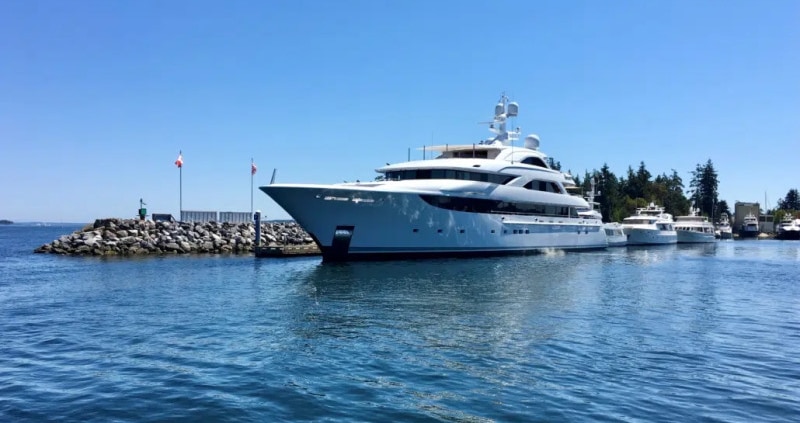
What is a Yacht? History, Types of Yachts, Styles, and Sizes
In this article, we explain the definition, history and origin of the word yacht, and break down some of the more common types of yachts along with various styles and sizes.
Yacht Definition & Origin
The word yacht comes from the Dutch word “jacht”, which means to hunt, and refers to the quick and lightweight sailboats the Dutch navy used to pursue pirates and other enemies in shallow waters. Today, the word takes on a very different meaning. While there is no strict definition of the word today, a yacht is generally considered as a boat used for pleasure, whether you’re cruising open waters, racing or island-hopping for the weekend. Typically, we consider a boat to be a yacht if it has an overnight cabin onboard, is more than 33 feet long, and generally looks nicer than your average vessel.
Pleasure boats have been around for hundreds of years, which is no surprise when you consider our options for transportation around that time. Without planes, cars, bikes or scooters, humans turned to the one form of transportation they knew well for pleasure – the ship.
Sailing Yacht History
Sailing yachts have been a thing since at least the beginning of the 1660s in Europe, when King James of England commissioned a sailing yacht for his son Henry, the Prince of Wales. But it was Charles II, the Kind of Scotland, who brought the term “yacht” into the mainstream after spending time exiled in the Netherlands. Once Charles got home, he began commissioning royal yachts left and right.
Steam Yacht History
Steam Yachts also have quite the history, which started as massive and luxurious sailing yachts with steam auxiliary engines. These yachts were much larger, and carried full crews complete with a cook, captain, engineer, stewards and deck hands. By the late 1700s, screw propellers were installed and the engines became far more efficient. Eventually, compound engines came about and persisted until the internal combustion took over.
Power Yacht History
Powerboats with 4-stroke gas engines were first developed by Nicolaus Otto and Gottlieb Daimler in 1876. Then in the 1900s, diesel engines became the more popular option because of their lower cost and improved reliability.
Yacht Types
Today, yachts fall into one of two general categories – sailing yachts and motor yachts.
Sailing Yachts
A sailing yacht is a leisure craft that relies on its sails for the primary method of movement, made from natural, synthetic or carbon fibers. Sailing yachts are split into two main categories: cruisers and raisers.
Cruising Yachts
A cruising yacht is designed for comfort above anything else. These yachts are ideal for overnight and lengthy journeys, typically equipped with all the comforts of home, including full kitchens (galleys), bathrooms (heads) and beds. They’re also designed to be slightly easier to maintain.
At the smaller end, we have what’s called as a “trailer sailer”. These yachts are generally shorter than 25 feet, and can be pulled by the average car. But anything shorter than 33 feet is considered a small sailing yacht. The next level is 33-45 feet, referred to as near-shore yachts. Offshore yachts are the largest category, including vessels larger than 45 feet.
Racing Yachts
A racing yacht is designed with performance top of mind, rather than comfort. World Sailing, the governing body for the sport of international sailing, recognizes 11 different classes of sailing yachts, but each share some general characteristics.
On a racing yacht, aerodynamics is prioritized. These yachts come in a variety of shapes and weights, but performance is the underlying motivation for all. Similar to aerodynamics but underwater, hydrodynamically efficient hulls allow boats to pull through the water with minimal drag or extra motion. Finally, for peak performance, these sailing yachts typically use full-battened Kevlar or carbon fiber sails.
Motor Yachts
Motor yachts come in all shapes and sizes, built with a variety of different materials. Generally speaking, they range from 30-130 feet in length, but there are superyachts out there exceeding 500 feet (that’s over 150 metres!).
The hull of a motor yachts comes in three basic styles. A yacht with a full-displacement hull moves the water up and away, creating waves. These boats have the potential to be plenty powerful, but their speed is limited. Semi-displacement hulls are slightly faster, because they’re able to partially rise above the water. Last are the yachts with a planing hull. These yachts are the fastest, because of a flat underside and enough power to lift them onto the surface of the water.
The majority of modern motor yachts have at least one diesel engine. A boat with two engines is certainly more expensive, but well worth it when you consider the reliability and increased handling/performance.
When it comes to motor yacht styles, there are many. Here’s a brief introduction to a few different motor yacht styles:
- Sport Motor Yacht : These powerful crafts are built with a semi-displacement and planing hulls, making them fast boats great for weekend adventures and short trips.
- Trawler Motor Yacht : A trawler is known for its more traditional style with a displacement hull, designed for medium distance passage-making.
- Cruising Motor Yacht : A cruising yacht is built for comfortable longer distance travel, equipped with a displacement hull.
- Expedition Yacht : Similar to a cruising motor yacht, expedition yachts are built with a displacement hull for long distances, but these crafts specialize in passage-making in remote areas.
- Mega Luxury Yachts : The mega luxury yachts is what you see and hear about on TV and in magazines. They’re hundred of feet long, designed for dozens of family and friends, and reserved for the super-rich.
- Sports Fisherman Yacht : These yachts have semi-displacement or planing hulls for quick fishing trips where you need to be able to move well. On a sports fisherman yacht, there will also be extra space for fishing gear and large fish.
- Lobster Yacht : A lobster yacht is similar to but quicker than a trawler, built with a semi-displacement or planing hull. These yachts get their name from their unique style – looking like classic Maine lobster boats.
If you’re looking for a new yacht, browse our current listings of sailing and motor yachts at Van Isle Marina. You can also visit us in Sidney at 2320 Harbour Road to see our stock in person, and our staff will be happy to help you out.
250 656 1138
2320 Harbour Road, Sidney, British Columbia V8L 2P6 [email protected]
Marina Services
Marina Layout
Yacht Sales
- Link to Facebook
- Link to Instagram
©2024 Van Isle Marina | Design by Caorda


One Of The World’s Largest VLCC Fleet Operators Set To Acquire 9 VLCCs For $1 Billion

Dutch Officials Seize Over 700 Kilos Of Cocaine At The Port Of Rotterdam

UK Invests $35 Million To Develop DRC’s First Deep Water Container Port

U.S. Approves First-of-its-Kind Floating Offshore Wind Energy Research Lease

When Were Boats Invented?
Boats have been used by mankind for thousands of years and are older than any other form of transportation. They have been used throughout history for transporting goods, and people, for conducting warfare, explorations, discoveries and conquests.
The current ships and sailing vessels are advanced versions of the ancient boats. They are just more comfortable and have modern amenities however the basic design and mechanism have remained unchanged. The last 150 years have been extremely crucial in the history of boats and shipping. Directed by the needs of colonization, capitalism and imperialism, boats have become bigger, better and more efficient.
It is interesting to know that the mastery over shipping and possession of a strong naval fleet was key to the dominance of the world in ancient and medieval times. It allowed Britain to carve out the biggest colonial empire in the 18th and 19th centuries. Similarly, it allowed the Portuguese, Dutch, Spanish and French to conquer the New World or Americas in the 16th and 17th centuries.
Table of Contents
History of boats- when were the earliest boats invented?
The history of boats is older than the history and the earliest evidence of writing in any civilization. The earliest boats were not built by modern humans but by their predecessors, the Homo Erectus about 800,000 years ago and this is how they probably spread from Africa to the other parts of the world.
Archaeological data states that the oldest boat in the world dates back to 8200-7600 BC. It is called the Pesse canoe and was discovered in the Netherlands. It was a three-feet long dugout, meaning it was made from a hollowed bark of the Pinus Sylvestris tree.
However, experts believe that boats were very much in use before that as well. This can be gauged from the earliest depiction of a ship on a rock carving in Azerbaijan dating back to 10,000 BCE! It showed a reed rowing ship carrying about 20 men.
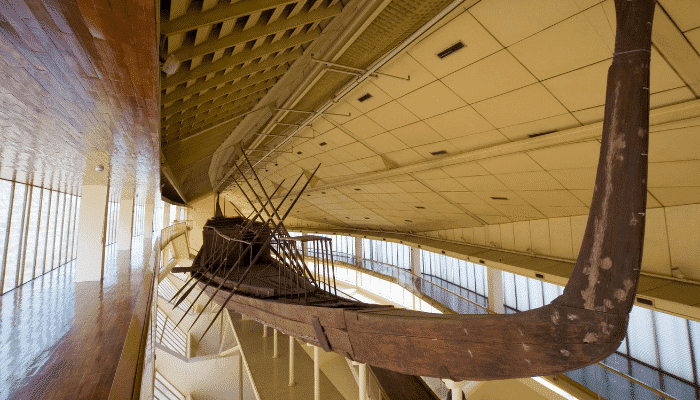
Another ancient boat is the Uru or the fast boat that promoted ancient seafaring activities. It was designed, constructed and used off the Indian coast. Evidence of its use has been found in Beypore, a village in southern Kerala. These kinds of boats were used by ancient Arabs and Greeks for conducting sea trade and they carried about 400 tonnes of goods in these boats in the early centuries.
Throughout history, the evolution of boats has been slow and continuous and they have been modified according to the needs and changing times. For instance, ancient boats were minimalistic and had a very basic design.
They were called rafts and were made from tree bark, reeds, and logs of wood. In ancient Egypt, these rafts were made using the reeds of Papyrus and were quite sturdy. Cave paintings and relief carvings show that these earliest rafts were used in other regions of the world as well such as Kuwait, Peru, Bolivia, Easter Island and Scandinavia.
Then in medieval and early modern times, there was the invention of warfare ships, steam liners and more recently passenger cruises for recreation and sailing ships for leisure and professional sports.
Tracing the development and evolution of boats
Many civilizations flourished and were then destroyed by the ravages of time. However, archaeological remains have survived and these inform us of the practices, culture and also modes of transportation. Let us look at how boats evolved.
Earliest sailing boats
The evidence of the earliest sailing boats is found in ancient Egypt and they operated in the Nile. The ancient Egyptians were dependent on the Nile for travel that was conducted from present-day Aswan. Relief carvings show that these boats were mainly used for transporting obelisks ( pillars erected at entrances of temples) on the river Nile from Upper Egypt.
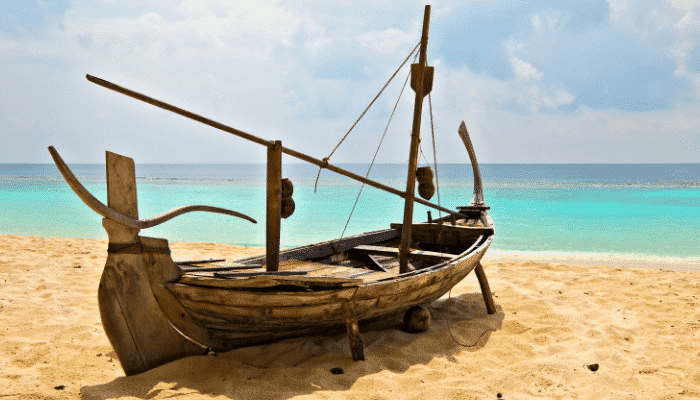
These boats had masts, sails and oars. They were about 100 meters and were quite durable. Since they were used in the Nile, rowing was required when winds were not dependable. These boats had a single square sail and a row of oarsmen. Later the Romans used the two and three-level bireme and trireme and these boats were huge so they employed more than a dozen oarsmen.
Use of Planks
Metal Age is dated to 3000 BCE when metal was beginning to be used in different ways. In shipping, it led to the development of planks that allowed the construction of larger ships for warfare and conducting trade. The earliest civilizations that made and used these ships were the Phoenicians, Greeks, and Egyptians.
Significant developments occurred in shipbuilding practices and about 2500 BCE, Egyptians started to venture out into the oceans, the Mediterranean and the Red Sea. They started making large wooden boats suitable for sea travel.
Galleys in Syria and Lebanon
From about 1550 to 300 BC, the Phoenicians from the Canaan civilization started manufacturing boats known as galleys. It was a vessel that was powered by men and used for trade and warfare. It had rows and many sails for gaining speed. They were very much in use till the 19th century. Galleys used for warfare were highly popular in the 16th century as this marked the age of exploration and discoveries. These galleys were also used as pirate ships and had ammunition and guns as well. The 1571 Lepanto war used hundreds of rowing ships and about 400 galleys and is the largest naval war recorded in history.
Long Boats built by Vikings
From 1000 AD, control over the seas and oceans for gaining political and economic paramountcy was realized by most kingdoms and civilizations. One such was a seafaring group from Scandinavia, called Vikings who raided, traded and settled in Europe from the 8th to the 11th centuries.
They constructed ‘longboats’ that were huge ships with sails. They were rowed by 60 to 70 men and were quicker, larger, but also narrow. This made them suitable for rivers and also long-distance open sea travel. They had long overlapping planks and a single huge mainsail. They were used for travel to and from Scandinavia and France, Britain and Spain.
Chinese Boats- Junks
From 1100 AD onwards, the Chinese started to build boats known as junks. These boats utilized rudders for steering and had watertight compartments. It also had battens on the sails that were used for transporting goods and also used as warships. These were much more advanced than the European ships that came in later and had similar features. The largest junk ship measured 150 m and had 9 masts.
Dutch Yachts
The Yachts were invented in the 14th century by the Dutch and were mostly used by rich Danish merchants. They were also part of the Dutch naval fleet at one time.
Galleon ships
The earlier galleys used oars but the Galleon ships of the Spanish had huge sails tied with numerous sturdy ropes. The sails were so broad that many people were required to put them in place. These were used in the 17 th century for transporting goods from the New World. These were also reformed into pirate ships.
Steam Ships
Britain remained a strong naval power but it lost its paramountcy to the United States after the latter achieved independence in 1776. From then Americans started building excellent ships at a much less cost than the British. The advent of the Industrial revolution during the same time led to the development of steam-powered ships, made for long-distance travel.
The earliest steamships were constructed in 1819 and transported cargo and passengers across the Atlantic. These ships worked on steam power. Their engines burned coal to heat water for producing steam in huge boilers. This steam drove the propellers or paddlewheels.
Clipper Vessels
The American ship makers had become one of the finest in the field by the early 1800s and they created Clipper ships. These ships were expansive, and had tall masts and long hulls that were directed for gaining speed quickly.
They had three masts, protruding bows and broad sails. The first clipper vessel was the Rainbow and it was constructed in New York in 1845. Another huge Clipper boat was the Royal Clipper which had a five-masted barque.
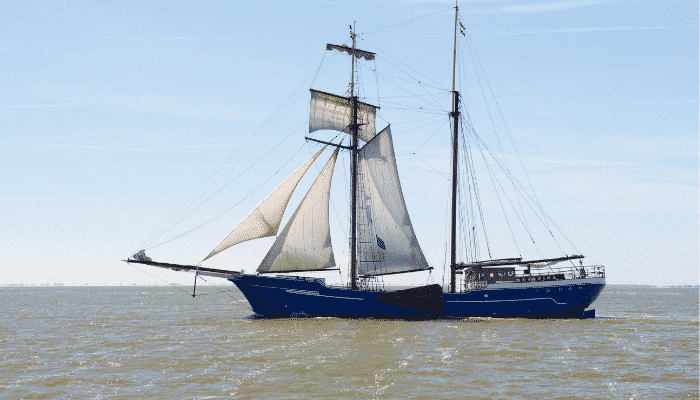
Many other clippers were also constructed in East Boston and were then used in the China-England tea trade after the British East India Company’s monopoly over the Chinese tea trade ended. After that, an American clipper ship called the Witch of the Wave reached England from Canton in only 90 days. In 1854, another clipper called the Lighting covered 436 miles in 24 hours creating new speed records. Thus, the use of clippers was a turning point in the history of shipping and trade.
Oceanliners
At the turn of the century, sails and masts began to disappear and also metal was extensively used for building ships. The first ocean liners were built in the late 18th century, around 1845 and extensively used iron. They had propellers and hulls made of steel.
Earlier Atlantic going ships had wooden hulls, and the new lever operated steam engines exerted enormous pressure on the rather fragile bottom in which they were fitted. This made repairs frequent and tiresome. The solution was found and it was iron hulls. This is what gave rise to the earliest ocean liners.
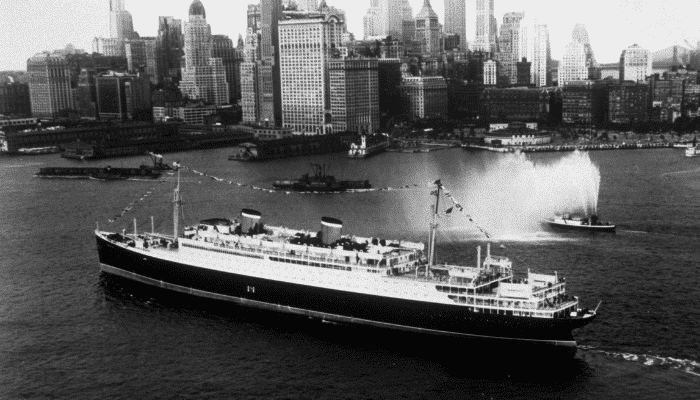
These ships were enormous and one such example is the Great Eastern which measured 692 feet, displaced 32,170 tonnes, and had a propeller, two paddle wheels and an auxiliary sail.
Stern Wheelers and Paddle Steamers
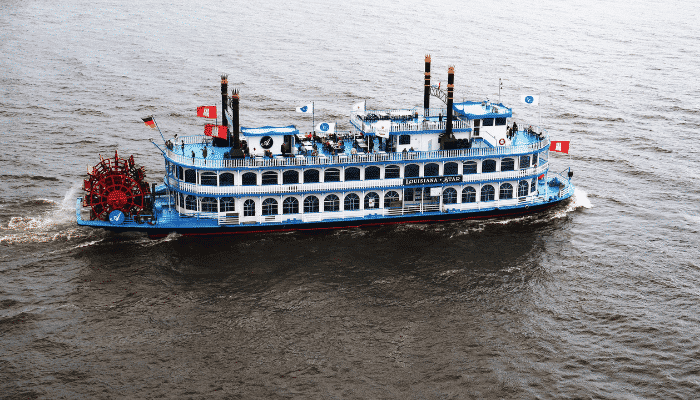
Apart from large ocean-going steamships, there were smaller vessels called paddle steamboats or sternwheelers that operated on rivers. There were paddle wheelers that had paddle wheels on both sides. These riverine boats were used for inland river transportation and travel in Britain and other regions of Europe in the 1880s. They were built for conducting coastal trade with neighbouring areas. As the name suggests, they used paddles and steam.
Diesel Ships
The earliest commercial diesel ships were made in the early 1900s. In 1904, a French diesel ship called Petit Pierre was constructed. It measured 125 feet and had a 25-hp engine with a pitch propeller to reverse it. It was a barge kind of ship and was used in inland waters of the Marne-Rhine canal.
From then onwards, diesel ships became commonplace and had a powerful motor engines.
The invention of the earliest Hovercrafts
Hovercrafts are a type of boat whose bottom is made of air-filled cushions. A hovercraft has three parts- a platform or its bottom, a motor fan and a skirt. The air enters the platform through the fan and the skirt prevents it from escaping outside.
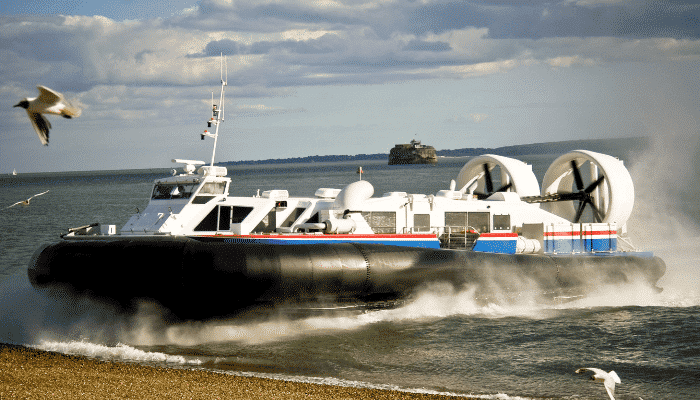
These are sturdy and currently used for various kinds of watersports, and also in military, rescue and search operations and by the Coast Guard. These are lightweight and easy to handle.
The earliest hovercraft was invented and tested by Christopher Cockerell in 1955. The first design was rudimentary and used cushions filled with air.
Container Ships
Over the 19th and the 20th centuries shipbuilding saw many technological advances resulting in the construction of large container ships that were used for international trade. These ships are designed to provide maximum storage space for containerized cargo on the decks.
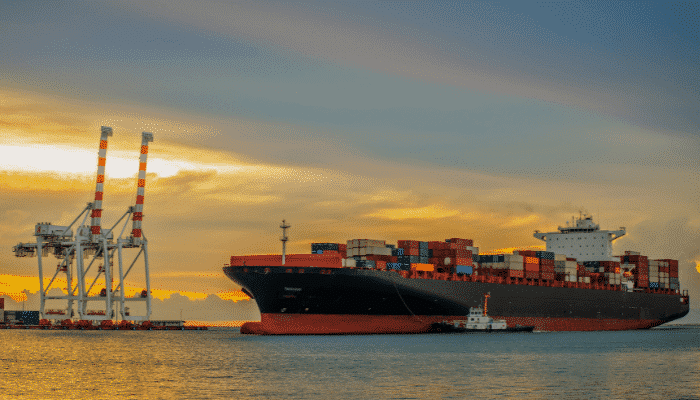
The hull of a container ship is a large warehouse that is divided into numerous compartments by vertical railings. These cells or compartments are made to keep packed containerised cargo. They are mostly made of steel but other substances such as aluminium, fibreglass and plywood are also used. Container ships carry different materials ranging from packaged food to metals and hazardous substances. Modern container ships can store more than a thousand containers.
Cruise Liners and passenger ships
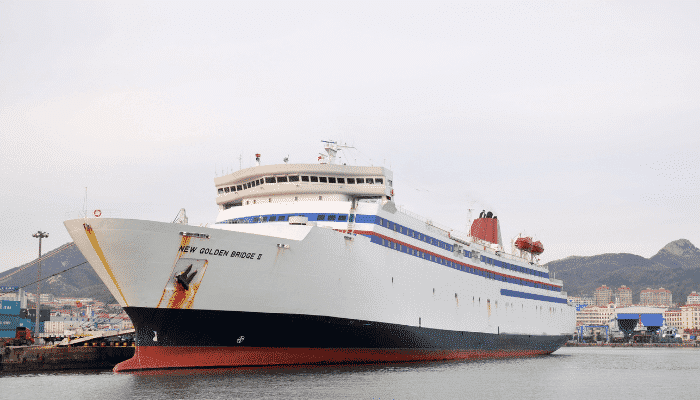
In the late 1990s, ships made for recreational purposes like passenger cruises came into vogue. They were exquisite, adorned with all comfort as they were designed for the rich. These could be used for recreational sailing, fishing or just exploring the waters. Since then, passenger cruises have become quite popular and many people love to spend their holidays on an exotic sea voyages.
Boats have been in use since times immemorial. They have evolved; the earliest ones were made of reeds and then wood and finally, iron and steel were used in their construction. They are indispensable and are used for the transportation of people, and goods, and are responsible for the diffusion of cultures, religions and practices across different regions.
You might also like to read:
- A Guide to Different Types of Boats
- Types of Sailboats: A Comprehensive Classification
- Types of Lifeboats Used On Ship
Disclaimer : The information contained in this website is for general information purposes only. While we endeavour to keep the information up to date and correct, we make no representations or warranties of any kind, express or implied, about the completeness, accuracy, reliability, suitability or availability with respect to the website or the information, products, services, or related graphics contained on the website for any purpose. Any reliance you place on such information is therefore strictly at your own risk.
In no event will we be liable for any loss or damage including without limitation, indirect or consequential loss or damage, or any loss or damage whatsoever arising from loss of data or profits arising out of, or in connection with, the use of this website.

Do you have info to share with us ? Suggest a correction
Daily Maritime News, Straight To Your Inbox
Sign Up To Get Daily Newsletters
Join over 60k+ people who read our daily newsletters
By subscribing, you agree to our Privacy Policy and may receive occasional deal communications; you can unsubscribe anytime.

BE THE FIRST TO COMMENT
Leave a reply.
Your email address will not be published. Required fields are marked *
Subscribe to Marine Insight Daily Newsletter
" * " indicates required fields
Marine Engineering
Marine Engine Air Compressor Marine Boiler Oily Water Separator Marine Electrical Ship Generator Ship Stabilizer
Nautical Science
Mooring Bridge Watchkeeping Ship Manoeuvring Nautical Charts Anchoring Nautical Equipment Shipboard Guidelines
Explore
Free Maritime eBooks Premium Maritime eBooks Marine Safety Financial Planning Marine Careers Maritime Law Ship Dry Dock
Shipping News Maritime Reports Videos Maritime Piracy Offshore Safety Of Life At Sea (SOLAS) MARPOL

Who Invented the Sailboat & When?

Last Updated by
Daniel Wade
August 30, 2022
Sailboats are a common sight on the water today. But how old is the basic design, and where do sailboats originally come from?
Nobody knows who invented the sailboat or exactly when, but archaeologists believe the first sailing workboats originated some 6,000 years ago. The modern sailboat began taking shape in the late 1800s and reached peak development after World War Two.
In this article, we’ll go over the origins of the sailboat and how simple wind-powered rafts evolved into the advanced and graceful sailboats we know today. We’ll cover all the major milestones in sailboat development and the origins of popular rigs like the Bermuda rig.
We sourced the information used in this article from credible historians and public archives.
Table of contents
Origin of Workboats
The sailboat is one of the oldest forms of boats in existence—but it wasn’t the first. Humans have probably been building boats and basic rafts for at least 6,000 years, using materials such as hollowed-out logs and bushels of buoyant reeds.
Reed boats date back to ancient Egypt, where people built basic reed canoes and more complex wooden boats. Early boats were pushed along rivers with a long pole or rowed with oars. But soon, people figured out that it was possible to harness the wind.
First Sailboats
Like many inventions, the sailboat probably originated in ancient Egypt. Around 4000 BC, Egyptians assembled a simple rigging system and suspended a piece of cloth in the air to pull basic log boats along rivers.
These vessels were long and narrow, and their simple rigging was difficult to control. However, the Egyptians had discovered that wind could do the work instead of oars.
By 3000 BC, the idea had spread extensively in the region, and sailboat design became more advanced. Most sailing still took place inland, and square sails became common throughout the ancient world.
Early Ocean-Going Sailboats
By 2000 BC, sailboats had grown in size and usefulness. Humans learned to maneuver reliably under wind power, and boat designs became more durable and efficient.
At this point, ocean trade networks were established all throughout the Mediterranean. Inland sailing was still quite common, and drawings from the era depict sailboats with both sails and oars for auxiliary propulsion.
The Romans were key in the development of sailing warships, which wielded archers and boarding parties armed with swords. Roman sailing vessels were also powered by sails and oars, though sailing was the primary method of propulsion when traveling long distances.
The Vikings were famous for developing hardy and seaworthy craft crewed by rowers and equipped with sails. The Vikings sailed extensively and settled many places with their vessels. After this point, sailboat development remained roughly the same until the 1400s.
Tall Ship Development
In the 1500s and 1600s, tall ships were well underway to becoming the dominant form of both merchant and sailing ships. The British, Spanish, and Chinese were notable early adopters of these types of ships, albeit with extensive variations.
These vessels would continue to increase in size, speed, and effectiveness as the decades progressed. Tall ships of the 17th and 18th centuries were the finest and most capable ever built, and several original examples remain seaworthy today.
Small Sailboat Development
Not much changed on small workboats until the 1600s. Most developments happened with larger ships, which had much greater economic and strategic value. However, during the 1600s or 1700s, the first Bermuda-rigged sailboats were developed.
The Bermuda rig, also known as the Marconi rig, would go on to be the most common rig type on all kinds of recreational sailboats. About a century later, the first yacht club was founded in Ireland—suggesting that recreational sailing first came into prominence around this time.
In the mid-1600s, recreational sailing of small boats became a popular activity for nobles in England. Documented evidence reveals that sailing up and down the Thames River was a popular pastime for royalty, and they developed some of the earliest known regattas.
19th and 20th Century Sailboat Design
The 19th and 20th centuries contributed the most to what we’d consider ‘modern’ sailboat design. During this era, world-famous marine architects and boatbuilders such as Nathanael Greene Herreshoff perfected small and medium-sized wooden sailboat designs.
By the 20th century, sailing workboats were not nearly as common as they were during the previous era. Instead, sailboats were used primarily for recreation and exploration. Some local fishing activity still took place, but sailing became more of a lifestyle than a necessity during this era.
The sailboat cabin was also popularized around this time, as the need for an open working space and cargo hold largely disappeared. Early sailboat cabins were sparse and rarely included standing headroom. Instead, simple folding canvas berths and a small wood or coal stove were the only amenities you could expect.
Modern Fiberglass Sailboat Era
The fiberglass boat era began after World War Two. Fiberglass, a material used extensively during the war, could easily replace planks or plywood in boatbuilding—and several companies such as Catalina sprung up during the 1950s and 1960s.
The decades between 1950 and 1990 were the height of fiberglass production boat building. Sailing became a popular pastime, and average Americans could eventually afford to purchase their own 25 to 35-foot sailboat. The vast majority of these sailboats featured extensive cabin amenities.
Most of these vessels were Bermuda (Marconi) sloops constructed with fiberglass and with varying levels of interior and exterior flash. Tens of thousands of boats were built by dozens of brands, and the majority of these vessels still remain on the water.
Most sailboats today were constructed during this era. Many famous designs from the fiberglass period are still produced—sometimes by the same company, sometimes by a new company or conglomerate. These vessels are fundamentally the same as sailboats from the early 20th century, but they require much less maintenance and tend to sail more comfortably.
Related Articles
I've personally had thousands of questions about sailing and sailboats over the years. As I learn and experience sailing, and the community, I share the answers that work and make sense to me, here on Life of Sailing.
by this author
Learn About Sailboats
Most Recent

What Does "Sailing By The Lee" Mean?
October 3, 2023

The Best Sailing Schools And Programs: Reviews & Ratings
September 26, 2023
Important Legal Info
Lifeofsailing.com is a participant in the Amazon Services LLC Associates Program, an affiliate advertising program designed to provide a means for sites to earn advertising fees by advertising and linking to Amazon. This site also participates in other affiliate programs and is compensated for referring traffic and business to these companies.
Similar Posts

Affordable Sailboats You Can Build at Home
September 13, 2023

Best Small Sailboat Ornaments
September 12, 2023

Discover the Magic of Hydrofoil Sailboats
December 11, 2023
Popular Posts

Best Liveaboard Catamaran Sailboats
December 28, 2023

Can a Novice Sail Around the World?
Elizabeth O'Malley
June 15, 2022

4 Best Electric Outboard Motors

How Long Did It Take The Vikings To Sail To England?

10 Best Sailboat Brands (And Why)
December 20, 2023

7 Best Places To Liveaboard A Sailboat
Get the best sailing content.
Top Rated Posts
Lifeofsailing.com is a participant in the Amazon Services LLC Associates Program, an affiliate advertising program designed to provide a means for sites to earn advertising fees by advertising and linking to Amazon. This site also participates in other affiliate programs and is compensated for referring traffic and business to these companies. (866) 342-SAIL
© 2024 Life of Sailing Email: [email protected] Address: 11816 Inwood Rd #3024 Dallas, TX 75244 Disclaimer Privacy Policy

Berthon Winter Collection

Latest issue

August 2024
In the August 2024 issue of Yachting World magazine: News Few finish a tempestuous Round The Island Race European rules are eased for cruising to France and Greece Olympic sailing…

Yachting World
- Digital Edition

The Yachting World hall of fame: 50 yachts that changed the way we sail
- Helen Fretter
- May 13, 2020
We asked historians, round the world race winners and legendary sailors to name the yachts that changed the sport for good. In no particular order, these are the 50 yachts that shifted how we sail...

Photo: Guido Cantini / Panerai / Sea&See.com
1. Mariquita
Built: 1911 Design: William Fife III
Mariquita is a living link between the ‘Big Class’ behemoths, such as Britannia , the J Class and all that went after, including the hugely popular 12-metres. The 125ft gaff cutter was launched as part of a new 19-metre class designed to pitch matched yachts against one another.
Just four were built. Mariquita performed well, particularly in light airs. She also, uniquely, survived. Having been used as a houseboat for many years, she was discovered in the mud in 1991 and lovingly restored to relaunch in 2003, and she still races today.

Photo: Oskar Kihlborg / Volvo Ocean Race
2. ABN Amro One
Built: 2005 Design: Juan Kouyoumdjian
Two Volvo Ocean Race -winning skippers nominated Juan Kouyoumdjian’s ABN Amro One , the 5.6m beam, aggressively chined winner of the 2005-06 race. Her skipper Mike Sanderson comments: “I am biased, but I think ABN Amro One was very special and really did change people’s thinking about what made a good offshore race boat.
“As this was the first generation of Volvo 70s it was always going to be an interesting time seeing how people translated the rule,” says Sanderson. The other factor was many of the team’s involvement in Open 60 sailing.
“We very much looked at the concept of the boat differently: no spinnaker pole, furling No.4 Jibs, twin rudders, lazyjacks, snuffers on spinnakers… They all went from being equipment that was only used on single-handed boats to our team thinking it could make us faster around the world, day in day out.”
Article continues below…


Yours for €2.75 million – Mariquita, the elegant and glamorous 125ft Fife design
Not very often does a yacht come on the market that has such a storied history behind her. Marquita, the…
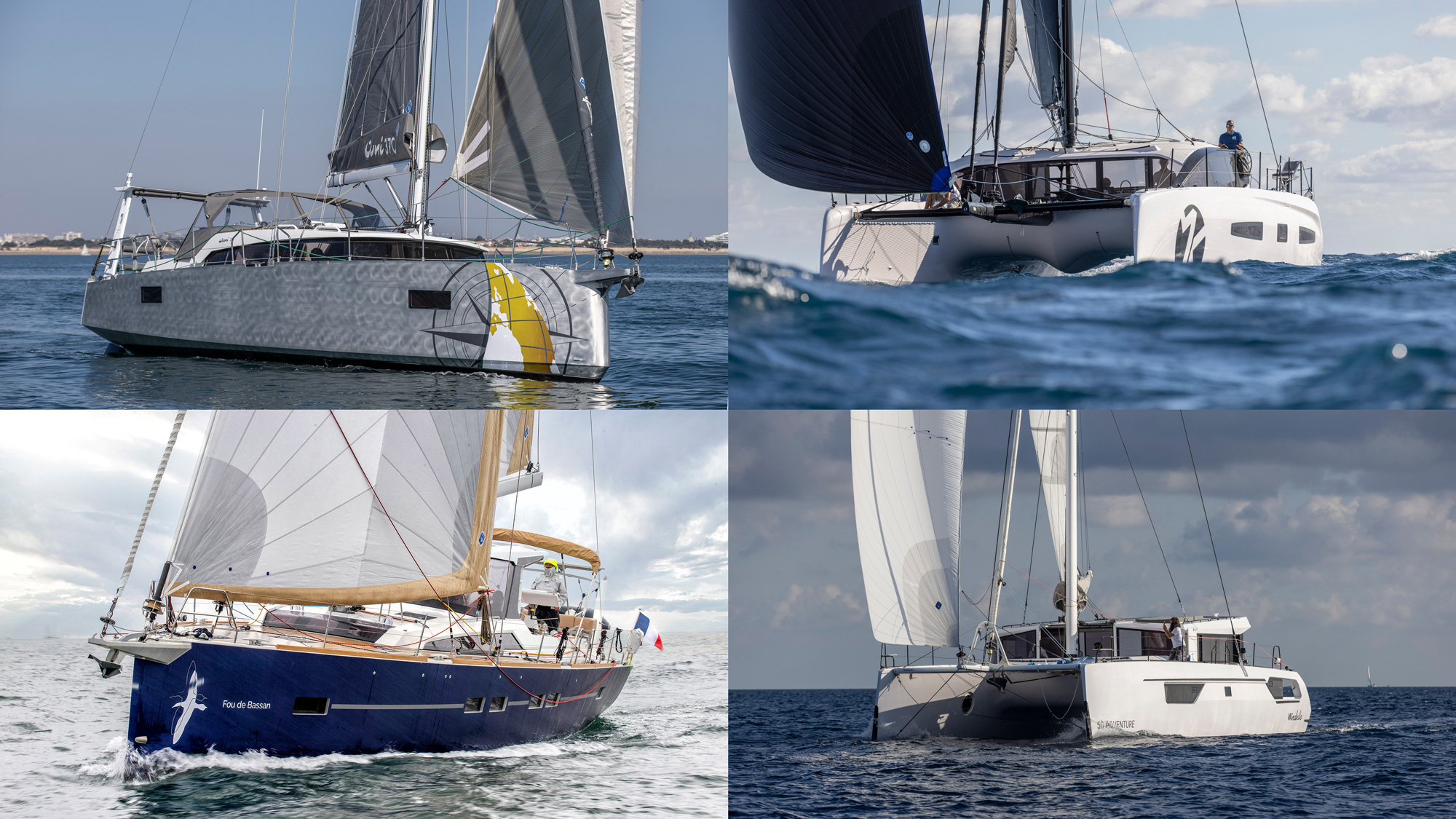
43 of the best bluewater sailboat designs of all time
Which yacht is the best for bluewater boating? This question generates even more debate among sailors than questions about what’s…
Ian Walker , winner of the 2014-15 Volvo Ocean Race, recalls: “This generation of boats smashed the previous 24-hour records and made the 600-mile day possible. ABN Amro was quite radical structurally but the key thing was she prioritised stability over anything else – such as wetted surface area.
“The Farr boats were lower wetted surface area and even started out with spinnaker poles! Asymmetric spinnakers meant sailing higher angles and more often needing righting moment.
“ABN Amro One also had twin rudders and more transom immersion, which meant it was slow in light winds but fast at high speed. There was some doubt when it was last in the first in-port races and because much of the race is in light winds, but it was so fast reaching that it negated any weaknesses.”
The black boat went on to win six of the nine offshore legs. Sanderson adds: “In all the Volvo 70s that where built – and to be honest in all the offshore boats that have followed ( Rambler , Comanche etc.) – you can see a bit of ‘Black Betty’ as we nicknamed her.”

Photo: Thierry Martinez
3. TP52 Patches
Built: 2007 Design: Reichel Pugh
Originally created to produce fast yachts for the Transpac Race, the TP52 class developed into an owner-driven inshore circuit which continues to attract the world’s best monohull sailors (these days as the Super Series). One development refined on the TP was the change to wide aft sections.
“We started off with quite narrow sterns and the working deck stopping well over one metre forward of the stern,” comments class manager Rob Weiland. “We now see an almost continuous width of the working deck from Beam Max aft and the working deck continuing to the stern.
“The ‘powerful stern’ is now the norm in offshore racing. I’m not sure whether we started it, but for sure, we were the test bed for how to refine that hull shape concept for windward leeward performance.”
First to have a working deck all the way aft was the 2007 Reichel Pugh Patches , a style then taken a stage further by ETNZ (2009), which added slab-sided topsides with a knuckle to create more hull stability when heeled. ETNZ also saw refinements in deck layout, elements of which have filtered down to more mainstream designs, such as transverse jib car tracks.

Photo: Ivor Wilkins Offshore Challenges / DPPI
4. B&Q Castorama
Built: 2004 Design: Nigel Irens
‘Mobi’, as she was affectionately known, was the 75ft trimaran designed by Nigel Irens specifically for Ellen MacArthur’s solo round the world record attempt in 2004.
B&Q Castorama was highly optimised, being longer, narrower, and with more freeboard than the ORMA 60s, reducing the risk of a pitchpole.
She was also, uniquely, custom built for a petite female skipper, with a full-scale mock up of the cockpit created at Offshore Challenges office. The trimaran took over a day off Francis Joyon’s record to finish in 71 days and 14 hours.
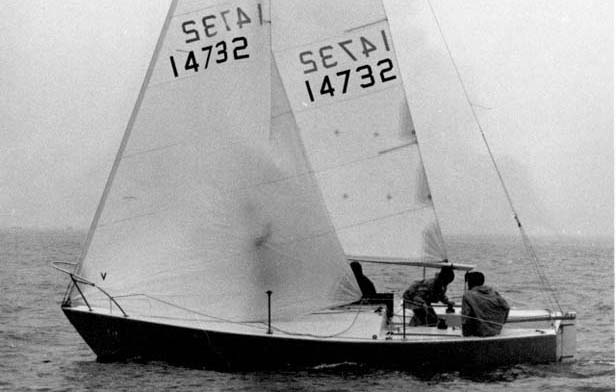
5. J/24 Ragtime
Built: 1976 Design: Rod Johnstone
It took 18 months for Rod Johnstone to build this 24-footer in his garage in Connecticut. It was designed to be simple to sail, with few rig adjustments, and light enough to be trailable. Rod’s family helped sand and finish the boat, and she was called Ragtime . Competing at their local race series in the summer of ’76, Ragtime was so successful that many people asked Rod for a sistership. He quit his job, and with brother Bob Johnstone set up J-Boats.
Their confidence proved well placed. Just two years later the J/24 class had its own one-design fleet at Key West in 1978, with 20 boats on the line. Now over 5,500 boats have been built and sold worldwide.
The J-boat line expanded to include one-designs like the J/70, as well as cruiser-racers such as the J/109. It has since has become synonymous with asymmetric sailing, doing much to popularise the use of asymmetric spinnakers on big boats.
- 1. Introduction
672 Wine Club
- Motorcycles
- Car of the Month
- Destinations
- Men’s Fashion
- Watch Collector
- Art & Collectibles
- Vacation Homes
- Celebrity Homes
- New Construction
- Home Design
- Electronics
- Fine Dining
- Benchmark Wines
- Brian Fox Art
- Disneyland Resort
- Gateway Bronco
- Royal Salute
- Sports & Leisure
- Health & Wellness
- Best of the Best
- The Ultimate Gift Guide
The 25 Greatest Superyachts of the Past 100 Years
Yacht design and technology—from steam engines to hydrogen fuel cells—have changed dramatically over the last century. these 25 standout vessels have been at the forefront of that revolution., julia zaltzman, julia zaltzman's most recent stories.
- These Charter Yachts Let You Tag Hammerhead Sharks and Count Spirit Bears for Research
- These Luxe Villas Are the Place to Stay in This Retro-Chic Enclave on the Tuscan Coast
- The 7 Most Exciting New Superyacht Marinas in the World
- Share This Article

A Century of Sea Change
Yachts have seen remarkable transformations in design and technology in the last 100 years. The lengths and shapes have changed decade by decade, from the mini-ocean liners of the 1920s to a more glamorous, fuller shape by the 1950s, eventually giving way to the layered wedding-cake construction that was so popular until about a decade ago. Now, just about anything goes, judging from the list below, with yachts boasting vertical bows being the most popular.
Technology also changed over the years, from steam engines to diesel to a growing list of hybrid diesel-electric powerplants. In the next five years, expect to see the first generation of superyachts with hydrogen- or methanol-powered fuel cells. What really hasn’t changed in the last century are owners’ desires to create superyachts that are unique, often clashing with the accepted design norms of the time.
Here are the 25 greatest superyachts from the last 100 years.
'Delphine' (257 Feet 9 Inches) 1923, U.S.A.

Delphine is the original 1920s oceangoing queen. American automobile magnate Horace Dodge commissioned the vessel, rumored to have once hosted former President Franklin D. Roosevelt and Winston Churchill, and Michigan shipbuilding company Great Lakes Engineering Works built it in 1921. At 258 feet, Delphine remains the largest yacht ever built in the U.S. that is still in operation. She is also the largest active steam-driven yacht in existence. The two original 1,500 hp steam engines were re-equipped with two modern water-tube boilers during a 2003 refit, which provide 18 metric tons of steam per hour. Surviving a stint in the U.S. Navy during World War II, several fires, and multiple owners, Delphine is today fully restored to her 1920s glory, including original teak on the main deck and a revived Tiffany-designed interior.
'Talitha' (247 Feet) 1929, Germany

Talitha is one of the world’s first superyachts with an exceptional pedigree. F. Krupp built the vessel, which was originally penned by naval architects Cox & Stevens (leading designers of their day), in Kiel, Germany. First known as Reveler , Talitha was delivered in 1929 to Russell Algar, chairman of the Packard Car Company. A string of high-profile owners ensued, including John Paul Getty Jr. in the 1930s, son of one of the richest men in the world at the time. Getty commissioned an exterior and interior redesign by late superyacht designer Jon Bannenberg and, in 1993, a full reconstruction was completed at the Devonport shipyard in Plymouth, U.K. Regular refits since, including a 1999 newly installed wheelhouse, has made Talitha successful as a popular charter yacht.
' Malahne' (164 feet) 1937/2015, UK

Originally designed and built for the owner of renowned J-Class yacht Velsheda , classic motor yacht Malahne enjoys a period interior designed by Scottish designer Guy Oliver (best known for styling London’s 10 Downing Street and Claridge’s). Original Art Deco features include Baccarat crystal, Willer porcelain, Georg Jensen silverware, and a lamp by 1930s designer Edgar Brandt. The yacht was once used as the production headquarters for Lawrence of Arabia and had luminaries such as Elizabeth Taylor, Grace Kelly, and Frank Sinatra walking the teak decks. In 2015, it underwent an extensive restoration at British shipyard Pendennis, which focused on maintaining its old-world glamour, including the yacht’s 25-foot custom-built Cockwells varnished Brazilian mahogany high-speed tender.
'Savarona' (446 Feet 9 Inches) 1931, Germany

Launched in 1931, Savarona was built for an heiress, enjoyed by royalty, and starred on the big screen. Built by Blohm & Voss for Emily Roebling Cadwalader, granddaughter of Brooklyn Bridge engineer John Roebling, 446-foot Savarona was featured in the German science-fiction film Gold . The Turkish government bought the vessel in 1938 and leased to Turkish businessman Kahraman Sadıkoğlu in 1989, who spent $45 million refurbishing the yacht. The original steam turbine engines were replaced with modern Caterpillar diesels, but the original 282-foot gold-trimmed staircase remains. Today, Savarona is the official presidential yacht of the Republic of Turkey.
'Shemara' (212 Feet, 2 Inches) 1938, Great Britain

Within a year of being built in 1938, 212-foot Shemara was requisitioned by the Royal Navy and used throughout World War II as a training vessel for anti-submarine warfare. Following the end of its service, the superyacht returned to her owner Bernard Docker, who entertained high society aboard its decks. Later in life, Shemara endured long periods of neglect until current owner Charles Dunstone acquired her in 2010, starting the long road back to refurbishment. Alongside much of the original teak and steel exterior features, Shemara is now fitted with a Rolls-Royce diesel-electric system, including two electrically driven azimuthing pods and a bow thruster.
'Christina O' (325 Feet) 1943/1954

Possibly one of the most eminent superyachts of all time, 325-foot Christina O didn’t begin life in the spotlight. Built in 1943 by Canadian Vickers, the vessel served as a frigate in World War II until 1954 when Greek shipping magnate Aristotle Onassis bought it as war surplus for a mere $34,000. He spent $4 million on the refurbishment and then entertained the world’s elite on board, from Maria Callas and Grace Kelly to Jack and Jackie Kennedy, prior to Onassis marrying Jackie. Named after Aristotle’s daughter, Christina O enjoys a bronze-edged swimming pool with a mosaic dance floor that rises at the push of a button. The stools in Ari’s Bar retain the original leather upholstery.
'V2V' (ex-Carinthia VI) (137 feet, 7 inches) 1973, Germany

The first major yacht designed by Jon Bannenberg and a breakthrough build for German shipyard Lürssen, Carinthia VI is a star of the decades, commissioned by supermarket magnate Helmut Horten as the sixth yacht in his Carinthia fleet. However, Carinthia V was in fact the original version but sadly hit an uncharted rock on her maiden cruise in the Mediterranean and sank. Horten ordered an almost identical replacement (this time with extra watertight bulkheads) and used Carinthia VI until his death in 1987. In 2016, the yacht suffered severe damage in a fire. Its new owner then bought the yacht, undergoing an extensive rebuild in Turkey to its original Bannenberg lines that was completed in 2023 when the yacht was renamed V2V.
'La Sultana' (214 Feet 56 Inches) 1962, Bulgaria

A Bulgarian passenger ferry turned Soviet spy vessel, 214.5-foot La Sultana has a checkered past. Built in 1962 for operations in the Black Sea, it was absorbed into the Russian fleet during the Cold War and sent to the North Atlantic for unofficial reconnaissance on the United States and United Kingdom. In 2015, La Sultana completed a seven-year refit, which saw the addition of a raised bow, seven guest cabins across six decks, and a diesel engine installed to drive the original propeller. Several spying instruments were also discovered, including a radioactivity detector and thick aluminum insulation across the entire boat. The original push button steering controls are still in operation.
'Highlander' (164 Feet) 1986, Netherlands

American media mogul Malcolm Forbes commissioned the 164-foot Highlander , built by Feadship to a Jon Bannenberg design with De Voogt naval architecture, in 1986. The yacht’s historic guest list reads like a who’s who of Hollywood stars, from Elizabeth Taylor to Robert De Niro. Two bathrooms in the master suite are offset by six guest cabins. Those lucky enough to charter this piece of yachting history also have use of Forbes’s original cigarette boat, now re-painted in jet black with a bold red stripe.
'Tatoosh' (303 feet) 2000, Germany

Built by Nobiskrug for cellular pioneer Craig McCaw, the 303-foot Tatoosh was more famously owned by the late Microsoft cofounder Paul Allen, who bought the yacht off McCaw in 2001. Penned by German designer Claus Kusch—with input over the years from Jon Bannenberg, Terence Disdale, Martin Francis, and Stefano Pastrovich— Tatoosh is arguably one of the foremost explorer yachts of the modern age. The vessel was conceived to be a world cruiser with all the toys and entertainment that a yacht could carry. Alongside two helicopter landing pads, it has 11 staterooms for 19 guests, a heated swimming pool with a lifting floor, a cinema, and a dive center with a nitrox refilling station for deeper dives.
'Al Salamah' (456 Feet 10 Inches) 1999, Germany

At the time of its construction in 1999, 456-foot Al Salamah was the third largest yacht in the world. The build began at German yard HDW in Kiel but was completed by Lürssen in Bremen, the only yacht builder at the time capable of meeting the owner’s demanding timeline. Al Salamah was commissioned by the late Saudi Arabian crown prince Prince Sultan bin Abdul Aziz. Estimated to be worth in the region of $200 million and accommodating 36 guests, the ample amenities include a cinema, a fully equipped onboard hospital, two full-time beauticians, a business center, and a spa.
'H' (ex-NEOM) (311 feet) 2000, Netherlands

Delivered in 2000, the 311-foot H remained the largest Oceanco yet built and the largest yacht built in Holland until the delivery of Kaos (ex- Jubilee ) in 2017. Originally named Al Mirqab , the vessel was a highly private yacht under the ownership of the Qatar royal family before ex-politician and co-owner of Formula One Force India team Vijay Vittal Mallya took ownership in 2006. The Maltese government seized the lavishly outfitted yacht, which includes a helipad large enough for a twin-engine helicopter, Elton John’s baby grand piano, a full medical suite, and triple engines each delivering 10,000 hp, in 2017 over unpaid maritime bills. NEOM was auctioned off to her current owner in 2018.
'Rising Sun' (453 Feet) 2004, Germany

Built for Oracle cofounder Larry Ellison in 2004 and currently owned by business mogul David Geffen, Lürssen’s Rising Sun is another Jon Bannenberg success story, completed two years after the designer’s death. Even with her 453-foot length and 7,841-gross tonnes volume, Rising Sun achieves an impressive top speed of 28 knots. The owners were impressed enough with the speed to build a suspended, tube-like walkway so visitors can see the four MTU 20V 8000 M90 diesel engines providing the power. A bank of full-height curved windows run along the entire length of the superstructure, flooding the interior with natural light and giving the yacht a striking exterior profile.
'Motor Yacht A' (390 feet, 4 inches) 2008, Germany

Few yachts divide opinion like M/Y A . Designed by Philippe Starck, engineered by naval architect Martin Francis, and built by Blohm + Voss, the yacht is rumored to have cost in the region of $300 million to bring to life. Characterized by its head-turning reverse bow and vertical superstructure, the vessel is a private floating fortress where guests’ access to the water is restricted to the stern. It boasts a cathedral-like tender garage and three swimming pools; it’s also the predecessor to the even more controversial S/Y A , which emerged nine years later and briefly held the place of world’s largest sailing yacht before being displaced by Koru.
'Dubai' (531 Feet 5 Inches) 2006, Germany

Prince Jefri Bolkiah of Brunei first commissioned Dubai in 1995 to be built in collaboration by German shipyards Blohm + Voss and Lürssen. But the superyacht was not completed until 2001 by Platinum Yachts when current owner, Sheikh Mohammed bin Rashid Al Maktoum, took over the project. British studio Winch Design crafted the exterior, and the vessel is reported to have cost in the region of $400 million to build. Dubai was the largest yacht in the world until 2010, when she was replaced by Roman Abramovich’s 533-foot Eclipse . Dubai ’s amenities, spread across eight decks, include a helipad, two 33-foot chase boats, a squash court, and 20 Jet Skis.
'Savannah' (273 feet, 11 inches) 2015, Netherlands

Savannah is renowned for being the first hybrid yacht on water, with fuel savings of up to 30 percent. It blends a single diesel engine with three gensets, batteries, a propeller, and an azimuting pioneering electro-mechanical propulsion platform. Built by Feadship, the yacht’s 41-foot beam was such a tight fit for the Dutch canals during delivery that the builder wrapped her in protective film and used plywood on the sides to serve as fenders. With its interior and exterior designed by Cristina Gherardi Benardeau, the yacht was also ahead of its time, with a corridor of double-height video walls, a floating superstructure, and an underwater Nemo lounge.
'Maltese Falcon' (289 Feet) 2006, Turkey

The legendary Maltese Falcon broke the mold of yacht design when launched in 2006. Perini Navi’s 289-foot, three-masted schooner was the result of its adventurous owner, the late Tom Perkins, and naval architect Gerard Dykstra’s radical design idea. The show-stopping Dynarig concept, now coined the Falcon Rig, catapulted Maltese Falcon to becoming the world’s most instantly recognized yacht, not to mention one of the most complex and largest sailing vessels ever built. The contemporary, computer-controlled sail system is based on freestanding carbon masts and yard-arms into which the sails furl. This system allows for easy sailing in all sea conditions. Famous charterers include Tom Hanks, Hugh Jackman, and Google cofounder Larry Page.
'Eclipse' (533 Feet) 2009, Germany

Aside from stealing the title of world’s largest yacht from 531-foot Dubai by a mere 1.5 feet, Eclipse is an exercise in amenities. Delivered to her owner Roman Abramovich in 2009, the vessel features a 52-foot swimming pool within an extensive beach club, two helipads, and a helicopter hangar under the foredeck. The 533-foot yacht is powered by a diesel-electric system driving azimuthing pods, one of the first of its kind. Eclipse retained the title of world’s largest yacht until the arrival of 590.5-foot Azzam in 2013. Designed inside and out by Terence Disdale, Eclipse took five years to build and is reported to have cost in the region of $590 million.
'Chopi Chopi' (262 Feet) 2013, Italy

Tasked with an experienced owner’s brief for a private yacht on which to spend long family holidays, CRN delivered with Chopi Chopi . The largest yacht built by CRN at the time of her 2013 launch, the 262-foot Chopi Chopi remains the Italian yard’s flagship. A 656-square-foot owner’s suite with private terrace is complemented by a helipad capable of landing a three-ton helicopter. The interior ceiling heights are in excess of seven feet. But the focus of the design is on comfortable outdoor living, realized by a large beach club with an adjoining sauna, hammam, and spa with a treatment room.
'Azzam' (590 Feet) 2013, Germany

At a whopping 590-foot, Azzam has held the title of world’s largest yacht since her launch in 2013. Azzam was built by German yard Lürssen in a record three years for Sheikh Khalifa bin Zayed bin Sultan Al Nahyan, the current President of the United Arab Emirates. Alongside a 95-foot main saloon, Azzam carries a submarine and its own missile defense system. Two gas turbines and two diesel engines propel the yacht through the water more than 32 knots.
'Black Pearl' (350 Feet) 2018, Netherlands

Delivered by Oceanco in 2018, the 350-foot Black Pearl is only the second yacht in the world to be fitted with Dykstra’s DynaRig carbon masts and sailing system. Its eye-catching black sails span 9,514 square feet and can be set in a record seven minutes with the push of a button. The hybrid propulsion system combines wind power with two electric propulsion motors, and its controllable pitch propellers generate enough energy to support the yacht’s hotel load. A waste heat-recovery system is just one of the onboard features that helps to realize the owner’s vision of a “zero-impact” yacht.
'Excellence' (262 Feet) 2019, Germany

Built for an experienced serial owner, American automobile magnate Herb Chambers, the Winch-designed 262-foot Excellence was delivered in 2019. The vessel takes its design inspiration from Motor Yacht A , which Chambers at first didn’t care for but then began to love. The piercing reverse bow (that mimics the beak of an American eagle) and triple-height glass-fronted atrium give it curb appeal but has also led to the yacht being likened to a spaceship. Driven by the desire to have a connection to the outdoors, the design rests upon a symbiotic relation between the indoors and out and was ultimately successful, partially due to the use hundreds of square feet of curved, mirrored glass panels.
'Koru' (417 feet) 2023, Netherlands

Oceanco’s 417-foot Koru , commissioned by Jeff Bezos, is a three-masted, black-hulled schooner with a bowsprit, classic lines, and white superstructure. Reportedly costing $450 million to build and accompanied by a 246-foot custom Damen support yacht Wingman , the new vessel is the world’s largest sailing yacht (knocking S/Y A off the top spot). Koru also holds the title of the largest superyacht ever built in the Netherlands and the tallest sailing yacht in the world, with masts that measure over 230 feet.
'Obsidian' (417 feet) 2023, Netherlands

Feadship’s 2023 delivery Obsidian has the appearance of a spaceship. But the boat’s technically advanced propulsion package, described as having a 90 percent reduction in total CO2 emissions, is what places it on this list, carrying the Dutch builder one step closer to its goal of achieving a zero-emission superyacht by 2030. The hybrid diesel-electric system is designed into a single-floor engine room creating additional interior space for owners, guests, and crew. With no drive shafts or rudders, the steering is done through a pair of electric Veth contrarotating thrusters. The diesel generators will also run on HVO, a second-generation biodiesel that manufacturers describe as a net-zero CO2 fuel. A low profile, horizontal styling features, and clean exterior shapes are a preamble for the yacht’s interior, which includes an underwater observation area—known as the Aqua Lounge.
'Luminance' (417 feet) 2023, Germany

Delivered in late 2023, Lürssen’s eighth largest build, Luminance , ranks as the 12th largest yacht in the world and is the 30th yacht built by the German shipyard with an exterior design by Espen Øino. The six-deck behemoth is one of the most significant yachts to be launched this year, with an internal volume of 9,000 GT, a beam of 66 feet, and an interior by Francois Zuretti. The gigayacht features two helipads, two Jacuzzis, a large swimming pool, and a distinctive stretched bow.
Read More On:
- Dream Machines 2020
- Motor Vessel
More Marine

Rescuers Find 5 Bodies Aboard the Sunken ‘Bayesian’ Superyacht

Tech Mogul Mike Lynch and 5 Others Are Missing After a Yacht Sinks in Italy

A Fleet of Candela’s Electric Foiling Yachts Is Rolling Out to the Red Sea in 2025

This New 116-Foot Pocket Explorer Will Make Larger Expedition Yachts Jealous

Meet the Wine Club That Thinks Differently.
Receive editor-curated reds from boutique California producers four times a year.
Give the Gift of Luxury
Latest Galleries in Marine

12 Must-See Yacht Debuts at This Year’s Cannes Fest

11 Fascinating Facts About Tankoa’s Library-Quiet 169-Foot Project Secret
More from our brands, maren morris brings sparkling suiting in david koma to 2024 democratic national convention in crystal-embellished blazer for performance, nwsl expansion talks include cincinnati and denver, how the dnc roll call went from snooze to sensation: dj cassidy on lil jon’s cameo and the playlist that turned a dull tradition into a dance party, seven ‘stunning’ viking arm rings discovered by archaeology student in denmark, the best yoga mats for any practice, according to instructors.
- History Classics
- Your Profile
- Find History on Facebook (Opens in a new window)
- Find History on Twitter (Opens in a new window)
- Find History on YouTube (Opens in a new window)
- Find History on Instagram (Opens in a new window)
- Find History on TikTok (Opens in a new window)
- This Day In History
- History Podcasts
- History Vault
The Floating White House: A Brief History of the Presidential Yacht
By: Evan Andrews
Updated: October 31, 2023 | Original: August 18, 2017

Before there was Air Force One, there was the presidential yacht. Dating back to the 19th century, America’s chief executives utilized navy ships and other vessels for recreation and entertaining foreign dignitaries. Nearly a dozen different ships acted as the “Floating White House” between 1880 and 1977, when the last vessel was sold at auction. During that time, they were the scene of international diplomatic summits, congressional schmoozing and the occasional Potomac River pleasure cruise.
The executive yacht “served an important purpose in enabling Presidents to escape the claustrophobic tension of the White House,” former Secretary of State Henry Kissinger has written. It “provided a quiet sanctuary; it was handier than Camp David, easier for casual, informal discussions.”
Abraham Lincoln made use of a steamboat called the River Queen during the Civil War , but the first official presidential yachts date to the Gilded Age. Starting in 1880, America’s commanders in chief sailed aboard a series of Navy vessels including USS Despatch , USS Dolphin and USS Sylph . In 1886, Despatc h famously ferried Grover Cleveland across New York Harbor for the dedication of the Statue of Liberty .

Presidential boating entered a new era in the early 1900s, when USS Mayflower took over as the chief executive’s official yacht. Unlike earlier vessels, which were relatively austere in their design, Mayflower was a luxury craft previously owned by real estate millionaire Ogden Goelet. Measuring some 275 feet from stem to stern, it boasted a crew of over 150 and had a sumptuous interior that included a 30-person dining table and bathtubs made from Italian marble.
USS Mayflower is most famously associated with Theodore Roosevelt , who often used it and USS Sylph for family vacation cruises along Long Island. A more official use came in August 1905, when Roosevelt hosted Japanese and Russian envoys aboard Mayflower as part of his attempts to mediate peace talks in the Russo-Japanese War . He would later win the Nobel Peace Prize for his role in ending the conflict.
Mayflower served as a presidential plaything for over two decades. Woodrow Wilson is said to have wooed his second wife Edith Bolling Galt during romantic jaunts aboard the ship, and Calvin Coolidge reportedly loved the yacht so much he stationed a Navy chaplain aboard so that he could take Sunday morning cruises without being accused of skipping church. Nevertheless, the ship’s opulence proved to be a sticking point with critics of presidential excess. In 1929, with economic concerns on the rise, Herbert Hoover finally had Mayflower decommissioned.

Mayflower was the largest and stateliest of the presidential yachts, but it wasn’t the last. Hoover—a devoted fisherman—soon began making day trips on a wooden-hulled vessel called USS Sequoia , and he eventually grew so attached to it that he had it featured on his 1932 Christmas card. Franklin D. Roosevelt began his tenure with Sequoia , but later switched to USS Potomac, a 165-foot former Coast Guard cutter that included a special elevator to help the wheelchair-bound president move between decks.
FDR occasionally utilized the ship for official business—it carried him to a 1941 meeting with British Prime Minister Winston Churchill —but it was more frequently used for presidential leisure. In his book Sailor in the White House: The Seafaring Life of FDR , author Robert Cross writes that Potomac provided Roosevelt with “an instant means of extricating himself from the confines of Washington. Roosevelt could escape to the open water, where he could do some politicking and thinking, or relax and entertain on deck with friends and advisors, or simply throw a fishing line overboard and patiently wait for a bite.”
Recreation was also the main role of the presidential yachts during the administration of Harry Truman , who hosted floating poker games aboard Sequoia and the 243-foot USS Williamsburg. Dwight D. Eisenhower was more of a landlubber than his predecessors, but sea excursions became popular again in the 1960s, when Sequoia resumed its former role as the main presidential yacht. John F. Kennedy —who also utilized a yacht called Honey Fitz and a sailboat called Manitou —celebrated his final birthday with a party aboard Sequoia. Lyndon B. Johnson installed a liquor bar and enjoyed having movies projected on the main deck.

As the longest serving of the executive yachts, Sequoia played host to several chapters in presidential history. The 104-foot vessel was a more humble affair than many of the other yachts, but the seclusion of its elegant, mahogany-paneled saloon made it an ideal location for sensitive political discussions. Harry Truman talked nuclear arms policy aboard the ship with the prime ministers of Britain and Canada. In the mid-1960s, Lyndon Johnson used yacht trips to hash out Vietnam strategy and lobby legislators to support his Great Society domestic reforms. “The Sequoia was a rostrum from which he was trying to persuade congressmen and senators,” former Johnson aide Jack Valenti said.
Richard Nixon was undoubtedly the most the enthusiastic user of Sequoia. The 37th president reportedly made as many as 100 trips aboard the yacht, including one in which he met with Soviet leader Leonid Brezhnev to negotiate the S ALT I nuclear arms agreement . Near the end of his second term, Nixon also used Sequoia as a hideout from the controversies of the Watergate scandal . During one final cruise in August 1974, the embattled president reportedly informed his family of his decision to resign before retiring to the ship’s saloon, quaffing a glass of scotch and playing God Bless America on the piano.

The age of the presidential yacht came to a close in 1977. That year, newly inaugurated Jimmy Carter ordered that Sequoia be offloaded in a public sale. Carter later noted that he was disturbed by the yacht’s $250,000 annual upkeep, but he was also following through on a campaign promise to dispense with the extravagance of the presidency. “Despite its distinguished career, I feel that the Presidential yacht Sequoia is no longer needed,” he wrote in a memo to his Secretary of Defense.
Today, Sequoia and Potomac are the only two former presidential yachts still in existence. Potomac went through several different owners after its presidential service—including Elvis Presley —and is now moored in Oakland, California. Sequoia, though currently inactive and in a state of disrepair, was once used as a floating museum and private charter boat, and still retains much of its presidential memorabilia. Both vessels are now registered as National Historic Landmarks.

HISTORY Vault: U.S. Presidents
Stream U.S. Presidents documentaries and your favorite HISTORY series, commercial-free

Sign up for Inside History
Get HISTORY’s most fascinating stories delivered to your inbox three times a week.
By submitting your information, you agree to receive emails from HISTORY and A+E Networks. You can opt out at any time. You must be 16 years or older and a resident of the United States.
More details : Privacy Notice | Terms of Use | Contact Us

- RIVIERA YACHTS
- BELIZE YACHTS
- DESIGN AND BUILD
- YACHT MANAGEMENT
- SUPERYACHT PROJECTS
- PRE-OWNED YACHTS
- NEWS & PR
- LEE MARINE TEAM
- COMPANY NEWSLETTERS
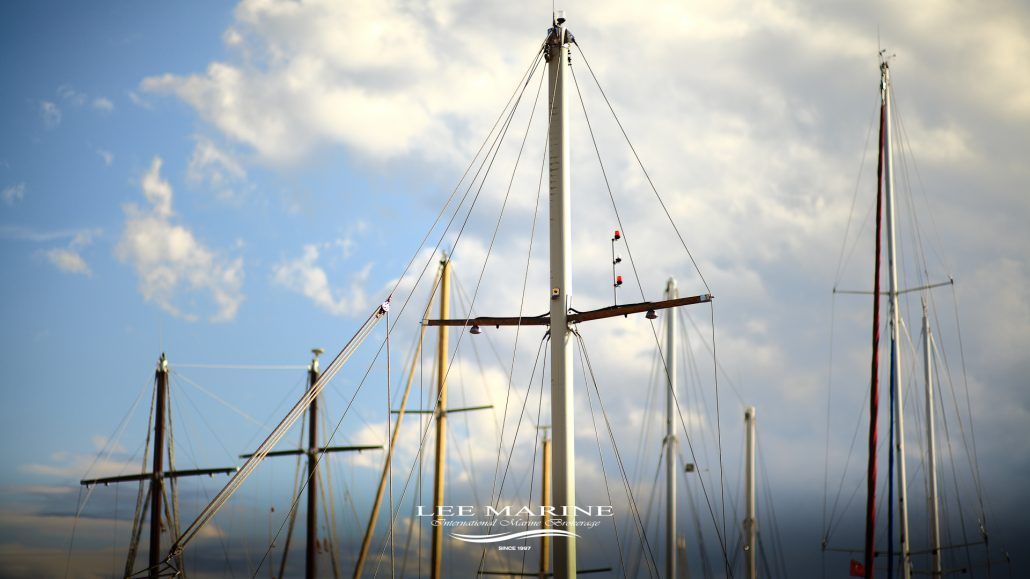
A Chronological History of Yachting, From Sailboats to MegaYachts
The allure of the open sea has captivated human imagination for centuries, and yachting stands as a testament to our enduring quest for adventure and luxury. From humble sailboats to extravagant megayachts, the history of yachting is a fascinating journey that mirrors the evolution of maritime technology, design, and societal trends.
A deep dive into the history of yachting
The roots of yachting can be traced back to ancient civilizations. The Egyptians and Phoenicians were among the first to use sailboats for leisure, employing them for recreational excursions rather than purely utilitarian purposes. As maritime exploration gained prominence, so did the idea of sailing for pleasure.
The Renaissance era
During the Renaissance, European nobility embraced yachting as a symbol of prestige and opulence. Elaborate galleons adorned with ornate carvings and luxurious furnishings became the playthings of kings and queens. Yachting evolved from a pastime of necessity to an expression of wealth and social standing.
The Golden Age in yachting history
The 17th and 18th centuries marked the Golden Age of Sailing, and racing became a popular pastime among the European elite. The sport of yacht racing was born, characterized by sleek and nimble vessels that competed for glory on the open water . The development of racing rules and the formalization of yacht clubs laid the foundation for organized yachting as we know it today.
Innovation and industrialization
The 19th century witnessed significant advancements in yacht design and construction. The shift from wood to iron and eventually steel allowed for larger and more seaworthy vessels. The advent of steam power revolutionized yachting, enabling vessels to navigate waters with or without wind. Pioneering designers like Nathanael Herreshoff and William Fife introduced innovations that improved both performance and aesthetics.
The America’s Cup and its impact on competitive yachting
The late 19th century also saw the establishment of the America’s Cup, the oldest international sporting trophy. This prestigious race, initiated in 1851, has been a driving force for yacht design and technology. The constant quest for speed and innovation in the America’s Cup has consistently pushed the boundaries of yachting.
The rise of motors: Yachting history is forever changed
The early 20th century witnessed the rise of motor yachts , as internal combustion engines became more reliable and accessible. Wealthy industrialists and celebrities embraced the newfound freedom and comfort offered by motorized vessels. Yachting transitioned from a pursuit primarily for the elite to a more accessible luxury .
Beyond World War II and the megayacht era
After World War II, the yachting landscape underwent a profound transformation. Advances in materials, propulsion systems, and navigation technology led to the development of megayachts—large, opulent vessels designed for maximum comfort and luxury. The iconic Christina O, once owned by Aristotle Onassis, epitomized this era of yachting extravagance.
Technological advancements
The latter part of the 20th century and the early 21st century saw rapid technological advancements in yachting. Computer-aided design (CAD), lightweight materials, and innovative hull designs improved performance and fuel efficiency. The integration of cutting-edge navigation systems and communication technologies enhanced safety and convenience on board.
Environmental awareness and sustainable yachting
In recent history, the yachting industry has faced increased scrutiny regarding its environmental impact . As a response, there is a growing emphasis on sustainability and eco-friendly practices. Hybrid propulsion systems, solar panels, and waste reduction initiatives are becoming integral to modern yacht design, reflecting a broader global awareness of environmental conservation .
From the humble beginnings of sailboats to the extravagant megayachts of today, the history of yachting is a captivating voyage through time. It mirrors the evolution of technology, societal values, and the human desire for exploration and luxury. Whether under full sail or cruising with the power of cutting-edge engines, yachting remains a symbol of freedom, adventure, and the timeless pursuit of the horizon.
Privacy Overview
| Cookie | Duration | Description |
|---|---|---|
| cookielawinfo-checkbox-analytics | 11 months | This cookie is set by GDPR Cookie Consent plugin. The cookie is used to store the user consent for the cookies in the category "Analytics". |
| cookielawinfo-checkbox-functional | 11 months | The cookie is set by GDPR cookie consent to record the user consent for the cookies in the category "Functional". |
| cookielawinfo-checkbox-necessary | 11 months | This cookie is set by GDPR Cookie Consent plugin. The cookies is used to store the user consent for the cookies in the category "Necessary". |
| cookielawinfo-checkbox-others | 11 months | This cookie is set by GDPR Cookie Consent plugin. The cookie is used to store the user consent for the cookies in the category "Other. |
| cookielawinfo-checkbox-performance | 11 months | This cookie is set by GDPR Cookie Consent plugin. The cookie is used to store the user consent for the cookies in the category "Performance". |
| viewed_cookie_policy | 11 months | The cookie is set by the GDPR Cookie Consent plugin and is used to store whether or not user has consented to the use of cookies. It does not store any personal data. |

The global authority in superyachting
- NEWSLETTERS
- Yachts Home
The Superyacht Directory
- Yacht Reports
- Brokerage News
- The largest yachts in the world
- The Register
- Yacht Advice
- Yacht Design
- 12m to 24m yachts
- Monaco Yacht Show
- Builder Directory
- Designer Directory
- Interior Design Directory
- Naval Architect Directory
- Yachts for sale home
- Motor yachts
- Sailing yachts
- Explorer yachts
- Classic yachts
- Sale Broker Directory
- Charter Home
- Yachts for Charter
- Charter Destinations
- Charter Broker Directory
- Destinations Home
- Mediterranean
- South Pacific
- Rest of the World
- Boat Life Home
- Owners' Experiences
- Conservation and Philanthropy
- Interiors Suppliers
- Owners' Club
- Captains' Club
- BOAT Showcase
- Boat Presents
- Events Home
- World Superyacht Awards
- Superyacht Design Festival
- Design and Innovation Awards
- Young Designer of the Year Award
- Artistry and Craft Awards
- Explorer Yachts Summit
- Ocean Talks
- The Ocean Awards
- BOAT Connect
- Between the bays
- Golf Invitational
- BOATPro Home
- Superyacht Insight
- Global Order Book
- Premium Content
- Product Features
- Testimonials
- Pricing Plan
- Tenders & Equipment
The Superyacht Directory is the world’s largest database of private luxury yachts, with over 12,000 megayachts listed. It’s the most authoritative place to find everything you need to know about superyachts – including new builds, historic vessels and the most famous boats of all time.
You can filter your Superyacht Directory search results by a number of specifications including speed, length and year of build, or select the builder, exterior designer or interior designer to narrow your search. With the Superyacht Directory, you can be as precise as you like, with options to filter by engine power, draught or displacement, propulsion system or hull material and more. You can use the Superyacht Directory to search by yacht type, breaking down your results into motor yachts, sailing yachts, explorer yachts or classic yachts.
Yacht search
Popular yachts, the fastest yachts in the world, the longest superyachts in the world, from our partners, sponsored listings.

What Is Yacht History Supreme? (The Fascinating Story Behind It)

For centuries, luxury yachting has been a long-time favorite among the wealthy, a symbol of their wealth and success.
Today, one yacht stands out among the rest for its sheer opulence and grandeurthe Yacht History Supreme.
This remarkable vessel has been at the center of attention for its luxurious amenities and features, as well as its mysterious owner.
This article will explore the fascinating story behind the Yacht History Supreme, from its history of luxury yachting to its recent sightings.
Get ready to explore the world of super yachts and experience the grandeur of the Yacht History Supreme!.
Table of Contents
Short Answer
Yacht History Supreme is a luxury yacht constructed by the Australian company, History Supreme.
It was designed by the British designer, Luiz de Basto, and is constructed from 100,000 kg of solid gold and platinum.
It is said to be the most expensive yacht in the world, with an estimated cost of $4.
The yacht features a master bedroom that is made from a single piece of 24-carat gold, and a sculpture of a T-Rex dinosaur made from bone-like material.
History of Luxury Yachting
The history of luxury yachting dates back centuries, when wealthy European families would use their ships to explore the world, show off their status, and even host extravagant parties.
The history of luxury yachting has evolved over time, as advances in technology have made it easier to build bigger and more luxurious vessels.
Today, luxury yachting is a billion-dollar industry, with people from all over the world investing in some of the most expensive and extravagant yachts ever built.
One of the most iconic yachts in the luxury yachting world is the Yacht History Supreme.
Built in 2011 by the Dutch-based firm, Lrssen Yachts, the Yacht History Supreme is one of the worlds most expensive and luxurious yachts.
It measures over 100 meters in length and features a gold-plated exterior, diamond-encrusted furnishings, and a helipad.
It also has a master suite, two VIP cabins, and other luxurious amenities.
The yacht is owned by an anonymous Malaysian businessman and is often seen off the coast of Monaco.
The Yacht History Supreme is a testament to the advances in technology and luxury that have been made in the world of yachting over the years.
It is a stunning symbol of the progress that has been made in the luxury yachting industry and a reminder of the importance of creating the most luxurious and opulent experiences for those who can afford it.
Yacht History Supreme Overview

Yacht History Supreme is a luxury yacht that stands out from the rest.
Built in 2011 by the prestigious Dutch-based firm, Lrssen Yachts, the vessel is one of the worlds most expensive and luxurious yachts, featuring a golden exterior, diamond-encrusted furnishings, and a helipad.
Measuring over 100 meters in length, the yacht has a master suite, two VIP cabins, and other luxurious amenities.
Its owner is an anonymous Malaysian businessman who has chosen to remain anonymous and is often seen off the coast of Monaco.
The interior of the yacht is just as stunning as its exterior.
The main deck features a luxurious salon and a dining room with an impressive glass table.
The yacht also features a gym and a sauna, as well as a private movie theater.
The upper deck is also filled with luxurious amenities, such as a bar and a jacuzzi.
The exterior of the yacht is just as luxurious and impressive.
The golden exterior is encrusted with diamonds, and the yacht also features a helipad.
The vessel is powered by two MTU diesel engines and is capable of reaching a top speed of 17 knots.
Yacht History Supreme is a symbol of luxury and extravagance, and its impressive features make it stand out from the rest.
Its golden exterior and diamond-encrusted furnishings make it one of the most luxurious yachts in the world.
Its no wonder that this yacht is often seen off the coast of Monaco, as its owner enjoys the luxury and extravagance of the vessel.
Features of Yacht History Supreme
Yacht History Supreme is a marvel of luxury and engineering, built in 2011 by the renowned Dutch-based firm Lrssen Yachts.
This luxurious yacht is an impressive 100 meters in length, and features a golden exterior, diamond-encrusted furnishings, and a helipad.
Inside, the yacht is outfitted with an opulent master suite, two VIP cabins, and other luxurious amenities.
The interior is decorated with fine woods, marble floors, and crystal fixtures.
The exterior features a large area for sunbathing, a Jacuzzi, and an outdoor bar.
The yacht also includes a spa, gym, and cinema.
The Yacht History Supreme is owned by an anonymous Malaysian businessman and is often seen off the coast of Monaco.
This impressive vessel is powered by twin MTU 20V4000 M93L engines and boasts a top speed of 16 knots.
It is equipped with the latest navigation, communications, and entertainment systems, making it the perfect choice for a luxurious, stylish getaway.
Luxurious Amenities of Yacht History Supreme

The Yacht History Supreme is truly one of the worlds most luxurious vessels.
Its golden exterior is complemented by its diamond-encrusted furnishings, making it a sight to behold.
The yacht is over 100 meters in length and boasts a master suite, two VIP cabins, and other lavish amenities.
The interior of the yacht is as luxurious as its exterior.
The master suite features a private balcony and a stunning view.
Guests can relax in the VIP cabins, which are equipped with private lounges and bathrooms.
The yacht also has a helipad, allowing for easy access to the vessel.
Other amenities include a spa with a sauna and massage rooms, a gym, a wine cellar, and an outdoor cinema.
It is one of the most expensive yachts in the world, and its luxurious amenities are sure to make any voyage a memorable one.
Whether youre looking to relax in a private balcony or enjoy a movie under the stars, the Yacht History Supreme has something for everyone.
The Yacht’s Owner
The Yacht History Supreme is owned by an anonymous Malaysian businessman, who has chosen to remain unknown to the public.
However, details of the owner have been slowly revealed as the yacht has been seen in various ports around the world.
The yacht is estimated to have cost somewhere between $4.
5 billion dollars, making it one of the most expensive yachts ever built.
This is a testament to the wealth and extravagance of its owner who, it is thought, is a successful businessman from Malaysia.
What makes the Yacht History Supreme so unique is its luxurious design and amenities.
It boasts a golden exterior, diamond-encrusted furnishings, and a helipad, which make it stand out from the rest.
It also measures over 100 meters in length, making it one of the largest yachts ever built.
Inside, the yacht features a master suite, two VIP cabins, and other luxurious amenities.
The Yacht History Supreme is often seen off the coast of Monaco and other locations around the world.
This is believed to be due to its anonymous owner’s preference for privacy and luxury.
The yacht has become a symbol of the wealth and power of its owner, who remains anonymous to this day.
The Yacht’s Grandeur

The Yacht History Supreme is truly a sight to behold.
From the outside, it is coated in a gold-plated finish, giving it a regal and luxurious feel.
The yacht is over 100 meters in length and features a master suite, two VIP cabins, and other luxurious amenities.
Its interior is adorned with diamond-encrusted furnishings, making it one of the most luxurious yachts in the world.
The yacht also has a helipad, allowing its owner to come and go in grand style.
It is the perfect combination of grandeur and luxury, making it the perfect vessel for the well-heeled traveler.
Recent Sightings of Yacht History Supreme
Yacht History Supreme has become a regular sight off the coast of Monaco, often spotted by tourists and locals alike.
Its impossible to miss, with its shining golden exterior and gleaming diamond-encrusted furnishings.
The yacht measures over 100 meters in length, and has a master suite, two VIP cabins, and many other luxurious amenities.
Its owner, an anonymous Malaysian businessman, has been seen on board numerous times, enjoying the sunshine, crystal-clear water, and the sounds of Monaco.
This yacht is often seen in the company of other luxury vessels, including mega yachts, super yachts, and even the occasional cruise liner.
Its a sight to behold, and one thats enjoyed by many who are lucky enough to witness it.
Yacht History Supreme has become an iconic symbol of wealth and luxury, and its not hard to see why.
The yachts helipad is also a popular spot for tourists to take pictures, as it provides a spectacular view of Monacos coastline.
Final Thoughts
Yacht History Supreme is an impressive feat of luxury yacht engineering and craftsmanship.
Its golden exterior, diamond-encrusted furnishings, and other luxurious amenities make it one of the most expensive and luxurious yachts in the world.
Owned by an anonymous Malaysian businessman, Yacht History Supreme has been seen off the coast of Monaco and is a sight to behold.
To truly appreciate the grandeur of Yacht History Supreme, we suggest taking a trip to Monaco and seeing it for yourself.
James Frami
At the age of 15, he and four other friends from his neighborhood constructed their first boat. He has been sailing for almost 30 years and has a wealth of knowledge that he wants to share with others.
Recent Posts
When Was Banana Boat Song Released? (HISTORICAL INSIGHTS)
The "Banana Boat Song" was released in 1956 by Harry Belafonte. This calypso-style song, also known as "Day-O," became a huge hit and remains popular to this day for its catchy tune and upbeat...
How to Make Banana Boat Smoothie King? (DELICIOUS RECIPE REVEALED)
To make a Banana Boat Smoothie King smoothie at home, start by gathering the ingredients: a ripe banana, peanut butter, chocolate protein powder, almond milk, and ice. Blend the banana, a scoop of...
[email protected] | +1-305-857-8939

- Yacht Search
- World’s 100 Largest
- World’s 100 Largest
Everything About Bertram Yachts – The History & Story
- Bertram Yachts
- Everything About Bertram Yachts –…
Bertram Yachts have a long American heritage that potential Bertram yacht owners should know about. In this blog, we have mentioned the complete history of the company that helped them get where they are right now. If you love reading history through a timeline, you are definitely going to like this one.
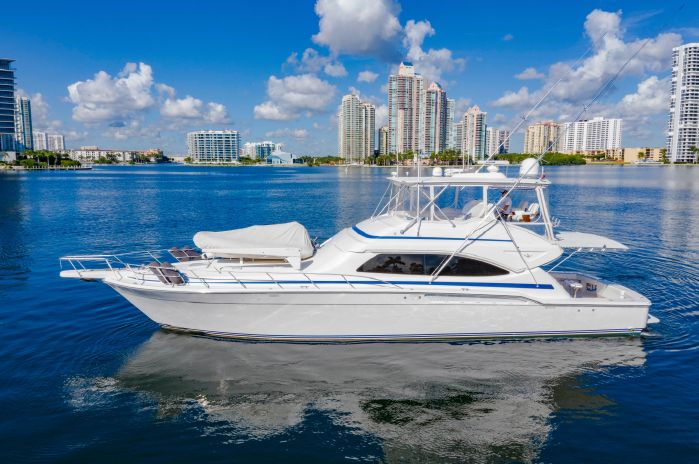
Timeline History and Story of Bertram Yachts
Richard bertram and his fondness for yachting.
Bertram was a competitive sailor and owned a yacht brokerage firm, outside of Miami that he started in 1947. This was his bread before he began the Bertram Yachts. But his fondness for yachting can be dated way back. He was about eight years old when he got his first boat which was a 15’ sneakbox. This was the age when boating became his favorite pastime.
While he was studying at Cornell University, he founded Cornell’s very own Corinthian Yacht Club. Under his participation, the university club won several sailing titles till 1937. He continued sailing even after moving to Miami and even made it to the World Lightning Class championships for the years 1948 and 1949. He went on to participate in several races only to find a company in the other two people. These people were Sherman F. “Red” Crise and Sam Griffith.
Foundation of Bertram Yachts (1960)
In 1958, while participating in one of his races, Richard Bertram noticed a 23-foot-long beauty and immediately fell in love with it. He had never seen a powerboat so magnificent that he himself wanted to own one. He asked the designer, C. Raymond Hunt, to design one for him. Using Hunt’s plan, Bertram in 1960 built his first powerboat yacht Moppie. It was named after his wife’s pet name. This laid the foundation of Bertram Yachts.
Bertram Yachts And The Legend of The 31 Moppie
The Bertram 31 Moppie stands as a testament to Bertram’s genius. The yacht quickly gained acclaim for its superior design and seaworthiness. This iconic vessel became a symbol of Bertram’s commitment to building high-performance yachts that could withstand the rigors of competitive racing and pleasure cruising alike.
Introduction of New Boats (1962, 1963 and 1964)
Bertram Yachts later went on to build new boats. There were three that were built, which were: The 25’ line in 1962 The 38’ line in 1963 The 20’ inboard/outboard model in 1964 While producing these yachts, Bertram decided to have its own production unit. Many people do not know but the production facility was designed in such a way that it could also work as a food-processing warehouse, just in case. Luckily, Bertram never needed it.
Memorial Race for Partner Griffith (1963)
Bertram’s partner passed away in 1963. So, Richard Bertram organized a memorial race to pay tribute to him. Not only did he organize but he also participated and won the race.
This event was not just a tribute but also a demonstration of Bertram’s enduring prowess and dedication to the sport. Dick Bertram participated in the race, showcasing his skill and determination. His performance was nothing short of remarkable. This victory elevated Bertram’s status to that of a celebrated yacht racer and influential figure in the maritime world. His triumph in the memorial race earned him significant media attention, leading to appearances in Rolex advertisements and billboards promoting Camel cigarettes. Bertram’s successful association with the title of ‘Champion’ solidified his legendary status and further cemented the Bertram name in the annals of yachting history.
Nautec Purchased Bertram
Despite Bertram’s success and the iconic status of the 31 Moppie, the yacht manufacturing business faced challenges following Bertram’s departure from the company. The factory experienced a period of stagnation, and the future of the Bertram brand seemed uncertain.
In the wake of this turmoil, Nautec, a prominent entity in the maritime industry, stepped in and acquired the Bertram brand. This acquisition was pivotal in revitalizing the Bertram legacy. Nautec’s investment in the Bertram facilities ensured that production resumed, and the Bertram name continued to be synonymous with quality and innovation in yacht building. Under Nautec’s stewardship, Bertram yachts retained their prestigious reputation, building on the foundation laid by Richard Bertram and his groundbreaking designs.
Whittaker Corporation Purchased Bertram (1968)
In 1968, Bertram Yachts underwent a significant transition when Whittaker Corporation acquired the company from Nautec. This change in ownership brought renewed vigor and ambition to Bertram. Under Whittaker’s stewardship, Bertram continued to dominate the competitive yachting scene. The brand maintained its reputation for high performance, clinching victories in various prestigious events. Whittaker’s investment in Bertram ensured the company not only retained its competitive edge but also expanded its influence in the yachting world.
The Era of Steady Growth (1970 to 1980)
The 1970s through the 1980s marked a period of remarkable growth for Bertram Yachts. During this era, the company capitalized on its strong foundation and continued innovations to expand its market presence. The steady growth was driven by Bertram’s commitment to quality and performance. The yachts produced during this period were renowned for their craftsmanship and advanced design, contributing to the brand’s increasing popularity among yacht enthusiasts. This growth era solidified Bertram’s position as a leading name in the industry, renowned for its luxurious and high-performance vessels.
Hatteras – The Arch-Rival of Bertram (1980s)
As Bertram Yachts continued to thrive, the 1980s brought a new challenge in the form of Hatteras Yachts. The competition between these two giants of the yachting world was intense. Hatteras emerged as a formidable rival, offering a more diverse range of models. The competition was not just about technological advancements but also about market share and innovation. Despite Bertram’s strong performance, Hatteras’s broader model range allowed it to capture a significant portion of the market. This rivalry was a defining moment for both brands, shaping the direction of the industry and the future of luxury yachts.
Financial Difficulties for Bertram (1993)
The early 1990s brought significant challenges for Bertram Yachts. The company’s focus on sportfishing boats, combined with a weakening American economy, created financial strain. The economic downturn affected the luxury goods market, and Bertram was not immune to these pressures. By 1993, the financial difficulties became severe, leading to a forced shutdown of the company. This period was a challenging chapter in Bertram’s history, marked by uncertainty and the need for strategic reassessment.
Bertram Yachts Purchased by Ferretti Group (1998)
In 1998, Bertram Yachts was revived when the Italian Ferretti Group acquired the brand. This acquisition marked a new era for Bertram, bringing fresh energy and innovation to the company. Under Ferretti’s ownership, Bertram underwent a significant transformation. The Italian group invested in modernizing the brand and introduced several new and impressive models. This revival not only reestablished the brand’s presence in the yachting world but also ensured the legacy of its high-performance and luxury yachts continued to thrive.
The Sad Demise of Richard Bertram (2000)
In 2000, the yachting world mourned the loss of Richard Bertram, the visionary founder of Bertram Yachts. His passing marked the end of an era for the company he had so profoundly shaped. His innovative spirit and dedication to yacht design established Bertram as a leader in the industry. Bertram’s legacy includes not only the groundbreaking designs of the 31 Moppie but also his contributions to competitive yachting, which helped define the standards for luxury and performance at sea. His death left a void in the world of yachting, but his influence continues to be felt through the enduring legacy of Bertram Yachts.
Acquisition of All Bertram’s Assets by Gavio Group (2015)
In 2015, Bertram Yachts experienced a new chapter when the Gavio Group acquired all of its assets. The acquisition by the Italian conglomerate marked a strategic move to revitalize the Bertram brand. Gavio Group, known for its investments in luxury and high-performance brands, planned to leverage Bertram’s history to introduce new models and innovations. This acquisition aimed to blend the brand’s legacy with modern advancements, ensuring the brand continued to deliver excellence in yacht design and performance.
Legacy and Influence
Bertram’s impact on yacht design.
Bertram Yachts has had a profound impact on yacht design over the decades. The brand is renowned for its emphasis on performance, durability, and innovation. The introduction of the Bertram 31 Moppie in the 1960s, for instance, revolutionized sportfishing yachts with its superior hull design and handling characteristics. Bertram’s commitment to engineering excellence set new benchmarks in the industry, influencing the design of sportfishing and luxury yachts worldwide. The company’s focus on creating vessels that excel both in competition and leisure has left a lasting mark on yacht design.
Influence on Other Yacht Manufacturers
Bertram Yachts’ pioneering designs and competitive successes have inspired many other yacht manufacturers. The company’s innovations in hull design, engineering, and performance have been emulated by other brands seeking to replicate Bertram’s success. The emphasis on high-performance and reliable construction established by the brand became a benchmark for others in the industry. As a result, many yacht manufacturers have adopted Bertram’s design principles, leading to a broader evolution in yacht design standards.
Contributions to Yacht Design Technology
Bertram Yachts has made significant contributions to yacht design technology. The brand’s use of advanced materials, innovative hull designs, and cutting-edge engineering techniques has driven technological advancements in the industry. Bertram’s commitment to integrating new technologies into their vessels has set a precedent for other manufacturers, fostering a culture of continuous improvement and innovation. The incorporation of these technologies has enhanced performance and improved the overall experience for yacht owners and enthusiasts.
Bertram’s Community and Culture
The bertram owner’s community.
The Bertram brand has cultivated a strong and dedicated community of owners and enthusiasts. The owners often share a deep appreciation for Bertram’s history and craftsmanship. This community is united by a common passion for high-performance yachts and a shared admiration for the Bertram legacy. The camaraderie among Bertram owners extends beyond the yachts themselves, creating a network of individuals who celebrate their shared experiences on the water.
Events, Clubs, and Gatherings Related to Bertram
Bertram Yachts fosters a vibrant culture through various events, clubs, and gatherings. These include yacht shows, regattas, and owner’s club meetings, where enthusiasts come together to showcase their vessels and celebrate the Bertram legacy. These events provide opportunities for Bertram owners to connect, share stories, and participate in the broader yachting community. The brand’s events and clubs help maintain the strong sense of tradition and community that has been a hallmark of the company since its inception.
The Present Scenario of Bertram Yachts
Despite the ups and downs and the acquisition changes, Bertram continues to be a popular yacht brand. In 2018, Bertram Yachts under the ownership of the Gavio Group introduced a new model, Bertram Yacht 61 Convertible at the Newport International Boat Show on September 13, 2018.
At Miami International Yacht Sales, we have an amazing lineup of Bertram yachts for sale . To own a Bertram, reach out to our expert yacht brokers now. Call us at +1-305-857-8939 to book an appointment today!
Also Read: Everything You Need to Know About Bertram Yachts Interesting Facts About Bertram Yachts
Inquire Now
Mike Lynch and daughter among missing after yacht sinks: What we know about disaster - and 'alarming' potential cause
The British-flagged luxury vessel named Bayesian was carrying 22 people when it got into difficulty off the coast of Sicily. Sky News looks at what we know about the tragedy.

News reporter @samuelosborne93
Wednesday 21 August 2024 19:01, UK
Please use Chrome browser for a more accessible video player

Six bodies have been found after a superyacht sank off the coast of Sicily.
Twenty-two people were on board the vessel named Bayesian when it got into difficulty in the early hours of Monday, with 15 people rescued.
Here's what we know about the sinking of the luxury vessel so far.
Follow latest updates on the superyacht sinking

What might have caused the sinking?
The British-flagged luxury vessel, named the Bayesian, capsized at around 4.30am local time on Monday morning off Palermo, according to ship-tracking site Marine Traffic.
It sank in a matter of minutes with 22 people on board, 12 passengers and a crew of 10, according to the Italian coastguard.
Waterspouts, essentially tornados which form over water, were seen as powerful winds battered the area overnight, local media said.

The yacht may have sunk faster with all the doors open due to the hot weather, Sailing Today magazine editor Sam Jefferson has said.
"I imagine all the doors were open because it was hot, so there were enough hatches and doors open that it filled with water very quickly and sank like that," he said.
Official pictures show air conditioning units in several of the rooms, however, which could counter the suggestion open windows caused the vessel to sink faster.
The huge mast is also likely to have played a role, he added.

What are waterspouts?
Waterspouts typically occur during thunderstorms and can develop very rapidly, within minutes.
Their spin generally reaches wind speeds between 75-200mph, but can reach as high as 300mph.
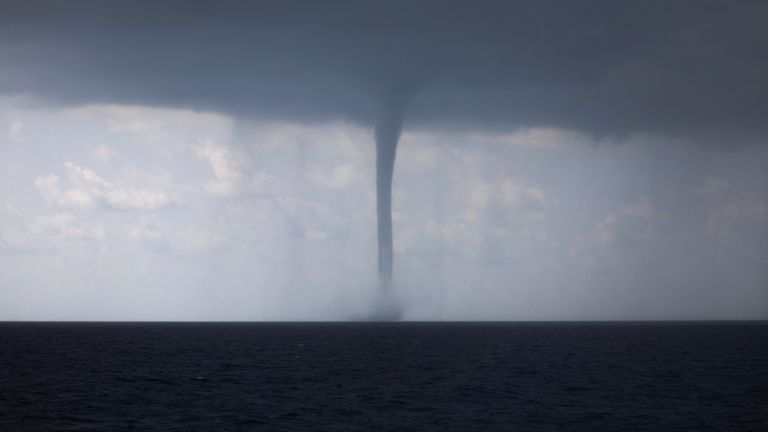
They can travel at about 10-20mph typically but can reach greater speeds, making them difficult to avoid - especially in something as slow-moving as a yacht.
Matthew Schanck, chair of the Maritime Search and Rescue Council, called the reports of a tornado or waterspout "rare" and "quite alarming".
"The vessel was at anchor in a recognised anchorage," Mr Schanck said.
"Depending on wind direction and the state of the sea, this informs the captain whether it is a safe area to anchor or not. There was nothing that was too concerning, for my eye. All in all, the captain used the information they had to make a safe call."

Who owns the yacht?
British tech tycoon Mike Lynch was among those missing, along with his 18-year-old daughter Hannah. His wife Angela Bacares was rescued.
Mr Lynch, 59, is known as the " British Bill Gates " and has been in the headlines in recent months over a high-profile fraud case.

In June, a US jury cleared him of all charges, which were related to the 2011 sale of his software company Autonomy to Hewlett-Packard (HP). The yacht trip is believed to have been a celebration of the end of Mr Lynch's legal troubles.
HP accused him of deliberately overstating the value of the company before it was acquired by the American tech giant.
Mr Lynch was extradited to the US to face trial in May last year and spent 13 months under house arrest in San Francisco as he awaited trial on 17 charges of conspiracy and wire fraud brought by the US Department of Justice - which were later reduced to 15 charges. He always denied any wrongdoing and was acquitted.
Read more: Lynch's co-defendant dies days before yacht sinking

Who was on board when the boat sank?
The passengers were largely British and American, the Italian coastguard said. Crew members were from New Zealand, South Africa, and Canada.
Charlotte Golunski was among the Britons rescued. Her LinkedIn profile says she is a partner at Mr Lynch's firm Invoke Capital and has worked there since 2012.

Speaking after the ordeal, Ms Golunski told Italian media that she lost her daughter Sofia for "two seconds" amid the "fury" of the sea but was able to retrieve her. She said she held the infant above the waves until the lifeboat was ready.
"Many people screamed. Luckily the lifeboat inflated and 11 of us were able to get on board," she told ANSA.
The girl's father James Emsley also survived, according to Sicily's civil protection agency.
Also on board were Jonathan Bloomer, chairman of investment bank Morgan Stanley, his wife Judy Bloomer, a top US lawyer Chris Morvillo, who worked on Mr Lynch's criminal case, and his wife Neda Morvillo. They were all reported as missing.
The yacht's captain James Calfield survived, along with South African crew members Leah Randall and Katja Chicken.

Recaldo Thomas, a Canadian-Antiguan chef who was working on the boat, has been found dead, the Italian Coastguard has confirmed to Sky News.
During rescue efforts, divers saw "corpses through the portholes" of the wreck as they recovered the body of a man at a depth of 50m (164ft), according to Salvo Cocina, the head of the Civil Protection of Sicily.

What do we know about the vessel?
The Bayesian is owned by a company controlled by the wife of Mr Lynch.
It was known for its unusual 72.3m (246ft) single mast - one of the world's tallest made of aluminium - and shared its name with the statistical method Mr Lynch's Autonomy software was based on.
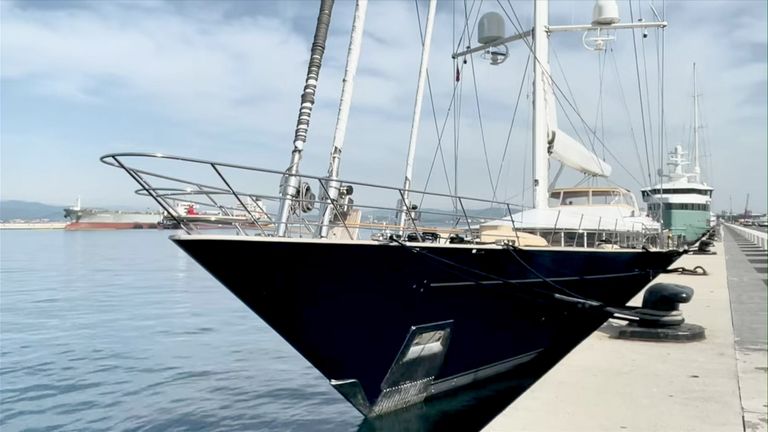
It was built by Italian company Perini Navi in 2008 and last refitted in 2020.
It was listed for rent for up to €195,000 (£166,000) a week, according to online charter sites.
The luxury vessel , which was managed by yachting company Camper & Nicholsons, can accommodate up to 12 guests in six suites.
It won a string of awards for its design, according to online specialist yacht sites.
Mr Schanck said the vessel would have been equipped with "high standard" life-saving appliances and radio communications. He added the yacht would have met all international standards and UK maritime coastguard agency regulations before its voyage.
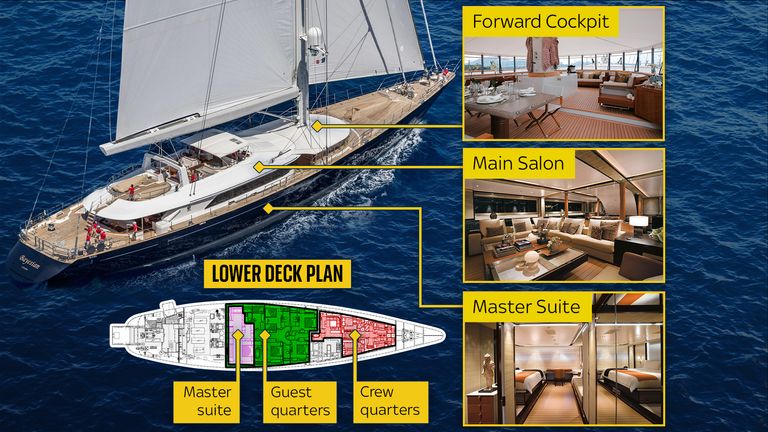
Keep up with all the latest news from the UK and around the world by following Sky News
The boat left the Sicilian port of Milazzo on 14 August and was last tracked east of Palermo on Sunday evening, with a navigation status of "at anchor", according to vessel tracking site VesselFinder.
The Bayesian previously travelled to other parts of Sicily before its last sighting off the coast of the port of Porticello.
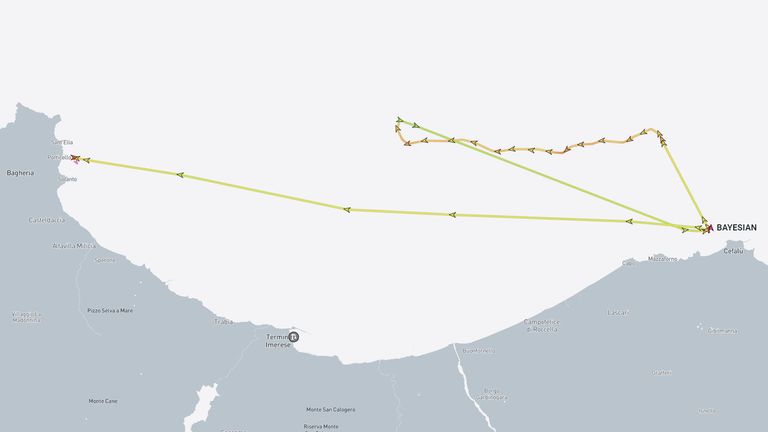
On Sunday, the boat was seen off the coast of Cefalu before it travelled towards Porticello, MarineTraffic data shows.
In the days before, the yacht travelled around four of the Aeolian islands, just north of Sicily.
It was previously named Salute, or "health" in Italian, when it flew under a Dutch flag. Its minimalist interior featured light wood with Japanese accents designed by the French designer Remi Tessier, according to descriptions on charter sites.
Be the first to get Breaking News
Install the Sky News app for free

Prosecutors in the nearby town of Termini Imerese have opened an investigation into the sinking.
Related Topics
- Superyacht sinking
JD Vance's military achievements misrepresented in viral post | Fact check

The claim: Walz receive nine different military awards and Vance only had two
An Aug. 10 Threads post ( direct link , archive link ) shows a list of military accomplishments for Ohio Sen. JD Vance and Minnesota Gov. Tim Walz, both of whom are now vice presidential candidates. Walz's rank, length of service and catalog of awards exceed those Vance has listed in the post.
"Tim Walz," reads the post's caption. "Valor earned."
The post garnered more than 300 likes in six days. Other versions of the claim were shared on Threads and Instagram .
More from the Fact-Check Team: How we pick and research claims | Email newsletter | Facebook page
Our rating: Partly false
The list for Walz is correct, but the post understates the number of awards and medals Vance earned during his military career.
Post misrepresents Vance's accomplishments
Yvonne Carlock, a spokesperson for the U.S. Marine Corps Manpower & Reserve Affairs, said Vance's military award history includes more than is listed in the post.
She said the Ohio senator served nearly four years, from Sept. 22, 2003, to Sept. 21, 2007, and reached the pay grade of E-4 as corporal, as the Threads post said. Vance's military occupational specialty, or MOS, was as a combat correspondent, according to Carlock.
Pay grade is tied to rank in the military, but is not necessarily the same thing, according to Veteran.com . The Threads post appears to conflate the two.
Though the post only lists two medals awarded to Vance, Carlock told USA TODAY he received six:
- Marine Corps Good Conduct Medal
- Navy and Marine Corps Achievement Medal
- Iraq Campaign Medal
- Sea Service Deployment Ribbon
- Global War on Terrorism
- National Defense Service Medal
Vance also received a Letter of Appreciation (5th Awd), Meritorious Mast. Certificate of Appreciation, Rifle Expert Badge (2nd Awd) and Pistol Expert Badge.
Fact check : Tim Walz coached for high school football team that won state championship
The post's description of Walz's service term and awards were corroborated by Minnesota National Guard spokesperson Army Lt. Col. Kristen Augé. She said Walz's military occupational specialties in Minnesota were cannon crewmember and field artillery senior sergeant, while in Nebraska he served as an infantry senior sergeant and an administrative specialist.
Walz's medals included:
- Army Commendation Medal
- Army Achievement Medals
- Army Reserve Components Achievement Medal
- Global War on Terrorism Medal
- Armed Forces Reserve Medal
- Noncommissioned Officer Professional Ribbon
- Army Service Ribbon
- Reserve Components Overseas Training Ribbon
The post's claim about Walz's highest rank is a bit oversimplified, however.
Augé said that Walz "culminated his career serving as the command sergeant major," reaching the highest pay grade for an enlisted member of E -9 . But he ultimately retired one rank lower as a master sergeant "for benefits purposes because he did not complete additional coursework at the U.S. Army Sergeants Major Academy."
USA TODAY was unable to reach out to the user who shared the post for comment.
Our fact-check sources:
- Yvonne Carlock, Aug. 14, Email exchange with USA TODAY
- Kristen Augé, Aug. 16, Email exchange with USA TODAY
- Department of Defense, accessed Aug. 16, U.S. Military Rank Insignia
- Veteran.com, Dec. 23, 2022, Military Pay Grade Vs. Rank
Thank you for supporting our journalism. You can subscribe to our print edition, ad-free app or e-newspaper here .
USA TODAY is a verified signatory of the International Fact-Checking Network, which requires a demonstrated commitment to nonpartisanship, fairness and transparency. Our fact-check work is supported in part by a grant from Meta .
- ENVIRONMENT
A sea tornado just sank a yacht in the Mediterranean. We might be seeing more of them.
A deadly waterspout is strongly suspected of sinking a yacht off the coast of Italy. Scientists weigh in on whether they’ll worsen as the planet warms.

A superyacht carrying 22 people, including British tech entrepreneur Mike Lynch, sank off the coast of Palermo, Italy, in the early hours of August 19.
The 183-foot Bayesian yacht is believed to have been hit by a waterspout —a tornado that forms over the ocean—and some experts are concerned that climate change could worsen these storms in the Mediterranean and other quickly warming waters.
Here’s what you need to know about waterspouts and whether hotter temperatures could cause more of them.
What is a waterspout?
A waterspout is a tornado that forms over water. “The tornado doesn't really care what surface it’s over,” says David Sills, executive director of the Northern Tornadoes Project in Ontario, Canada. “Whether it's a city or a forest or crops or water, the tornado is going to do its thing."
These columns of rotating air “form where an air boundary exists, for example where warm and cold air collide,” says a spokesperson at the Australian Government Bureau of Meteorology (BOM) via email.

Changes in wind direction at different heights can cause a rotation.
“Imagine just above the ocean, the wind is blowing in one direction,” says Peter Inness , meteorologist at the University of Reading. When the wind higher up blows in another direction, “the air between those two levels of wind starts rotating around the horizontal axis.”
The warm air below rises and these “spinning parcels of air are also lifted and stretched in this process and can concentrate on the surface of the water creating a vortex,” says the BOM.
As the air is sucked upwards into the storm, the spinning intensifies like taking the plug out of the bath, says Innes: “the water going down the plughole rotates very intensely because it's being sucked downwards.”
It’s similar to a figure skater, adds Sills: “When they bring in their arms, and then they spin faster and faster.”
How dangerous are waterspouts for boats?
Although the wind associated with waterspouts can reach 55 miles per hour, they typically move at under 25 miles per hour, are short-lived, and don’t cause much damage. “They usually only impact any single point for a few minutes,” says the BOM.
The Bayesian was moored overnight when it sank. Although people have attributed this to a waterspout, it’s not yet been confirmed.
“It was dark and there are no images available,” says Luca Mercalli, president of the Italian Meteorological Society , via email.
Boats are designed to right themselves when blown over by strong winds. “Those sailboats have a big, heavy keel so that when you start to go over, it pulls you back up,” says Sills.
But if water gets into the ship, it can lose buoyancy. “It's called a knockdown,” he says. “Time spent over like that means water and waves can get into open doors and it starts to take on water. Then you start to sink.”
The rapid change in wind strength and direction are also dangerous for boats, says Innes, “because it could result in the boat rocking backward and forward very violently.”
Will climate change cause more waterspouts?
One study has found more frequent waterspouts off the coast of Spain’s Balearic Islands when sea surface temperatures are higher, particularly between 73 and 78°F.
This year, “the Mediterranean is [over 5°F] above average,” says Mercalli, which is “an anomaly considered "extreme". These unusually warm waters could be partly due to climate change as well as year-on-year variability.
Some people are concerned that climate change could cause an increase in tornadoes on land and water.
“Global warming will increase all weather extreme events, because it injects more energy into the atmosphere,” says Mercalli.
But experts are wary of confirming a definite link with climate change. “Waterspouts are a very short-lived and local scale phenomena, and therefore difficult to attribute to impacts of climate change,” says the BOM.
The Mediterranean is warming more quickly than the rest of the ocean. Although climate change will make sea surface temperatures warmer, it’s unclear how it will affect the other conditions needed to create waterspouts.
Waterspouts need a temperature difference between air and sea. If the air is warming at the same rate as the bodies of water, an increase in waterspouts is unlikely, says Sills.
Low pressure is also needed. “Even if the water is really warm, if you've got an area of high pressure over the Mediterranean, you won't get those thunderstorms,” says Inness. “You won't get waterspouts.”
Wind direction also comes into play. In this region, humid air from the north is more likely to cause storms than dry winds coming up from North Africa.
Due to poor historic data, it’s not possible to confirm that waterspouts are increasing, says Mercalli, “but surely all heavy storms, including thunderstorms that generate strong winds, downbursts, heavy rains and hail are increasing worldwide and in Italy.”
Become a subscriber and support our award-winning editorial features, videos, photography, and much more.
For as little as $2/mo.
Related Topics
- CLIMATE CHANGE
You May Also Like

'Twisters' put storm chasing on the map—but here's what it's really like

How wildfires unleash fire clouds—and even fire tornadoes

The link between extreme weather and climate change has never been more clear

2024 hurricane season forecasted to be record-breaking year

Are the Great Lakes the key to solving America’s emissions conundrum?
- Best of the World
- Interactive Graphic
- Environment
- Paid Content
History & Culture
- History & Culture
- Out of Eden Walk
- Mind, Body, Wonder
- Terms of Use
- Privacy Policy
- Your US State Privacy Rights
- Children's Online Privacy Policy
- Interest-Based Ads
- About Nielsen Measurement
- Do Not Sell or Share My Personal Information
- Nat Geo Home
- Attend a Live Event
- Book a Trip
- Inspire Your Kids
- Shop Nat Geo
- Visit the D.C. Museum
- Learn About Our Impact
- Support Our Mission
- Advertise With Us
- Customer Service
- Renew Subscription
- Manage Your Subscription
- Work at Nat Geo
- Sign Up for Our Newsletters
- Contribute to Protect the Planet
Copyright © 1996-2015 National Geographic Society Copyright © 2015-2024 National Geographic Partners, LLC. All rights reserved

IMAGES
COMMENTS
The history of sailing yachts begins in Europe in the beginning of the 1600s with the building of a pleasure vessel for the son of King James I of England. While other monarchs used naval ships for transportation and conquest, James I was the first English monarch to commission the construction of a yacht—for his son Henry, Prince of Wales in ...
The yacht is an invention of the 14th century Dutch. The Dutch used small, fast boats for chasing smugglers, pirates and criminals. Rich ship owners and merchants began using these small " jaghts " to sail out to celebrate their returning merchant ships. It quickly became chic to use these " jaghts " to take friends out just for pleasure.
Today, ships, boats, and yachts are built using advanced technology and materials, differing greatly from those that have been used throughout history. Timeline of Ships, Boats, and Yachts. 4000 BC: The ancient Egyptians used reeds to build what are thought to be the first sailing boats in the world. The reed boats had sails and a mast and were ...
Boats have played a crucial role in the development of human civilization since time immemorial. They have served as vehicles for transportation, tools for exploration, and platforms for cultural exchange. The history of boats spans thousands of years, reflecting our innate curiosity and desire to conquer the vast expanses of water that cover ...
Below is a timeline of the history of various types of boats and the advent of any significant shipping features. Rafts. Most of the earliest boats were lashed together rafts of anything that would float (e.g., reeds, bamboo, balsa, and other woods, etc.). All of these types of rafts and small boats are still in use today around the world.
Sailing Yacht History. Sailing yachts have been a thing since at least the beginning of the 1660s in Europe, when King James of England commissioned a sailing yacht for his son Henry, the Prince of Wales. But it was Charles II, the Kind of Scotland, who brought the term "yacht" into the mainstream after spending time exiled in the Netherlands.
The history of boats is older than the history and the earliest evidence of writing in any civilization. The earliest boats were not built by modern humans but by their predecessors, the Homo Erectus about 800,000 years ago and this is how they probably spread from Africa to the other parts of the world.
Ship - Maritime, Navigation, Exploration: Surviving clay tablets and containers record the use of waterborne vessels as early as 4000 bce. Boats are still vital aids to movement, even those little changed in form during that 6,000-year history. The very fact that boats may be quite easily identified in illustrations of great antiquity shows how slow and continuous had been this evolution until ...
Maritime history is the study of human interaction with and activity at sea. It covers a broad thematic element of history that often uses a global approach, ... The U-boat threat lessened in 1917, when merchant ships [105] entered convoys escorted by destroyers. [106]
boat, generic term for small watercraft propelled by paddles, oars, sail, or motor, open or partially decked, and usually less than 45 feet (roughly 14 metres) in length. A vessel larger than this is customarily classed as a ship, although the word boat is often applied to certain working vessels—such as tugboats —that may be of ...
First Sailboats. Like many inventions, the sailboat probably originated in ancient Egypt. Around 4000 BC, Egyptians assembled a simple rigging system and suspended a piece of cloth in the air to pull basic log boats along rivers. These vessels were long and narrow, and their simple rigging was difficult to control.
The History of Yachts. The term yacht has been around since the 1600s, and it has come to represent a broad range of luxurious recreational boats. The word itself is derived from the Dutch term jacht, which translates to hunt. In the 1600s, yachts were used for military purposes, such as scouting and patrolling.
Originally created to produce fast yachts for the Transpac Race, the TP52 class developed into an owner-driven inshore circuit which continues to attract the world's best monohull sailors (these ...
Marine. November 13, 2023. The 25 Greatest Superyachts of the Past 100 Years. Yacht design and technology—from steam engines to hydrogen fuel cells—have changed dramatically over the last ...
As the longest serving of the executive yachts, Sequoia played host to several chapters in presidential history. The 104-foot vessel was a more humble affair than many of the other yachts, but the ...
From the humble beginnings of sailboats to the extravagant megayachts of today, the history of yachting is a captivating voyage through time. It mirrors the evolution of technology, societal values, and the human desire for exploration and luxury. Whether under full sail or cruising with the power of cutting-edge engines, yachting remains a ...
The Superyacht Directory. The Superyacht Directory is the world's largest database of private luxury yachts, with over 12,000 megayachts listed. It's the most authoritative place to find everything you need to know about superyachts - including new builds, historic vessels and the most famous boats of all time.
The History of Cruisers Yachts | American-Made Luxury Yachts. The History of Cruisers Yachts dates back to 1904 when Peter and Chris Thompson co-founded the Thompson Bros Boat Manufacturer Company in Peshtigo, WI. This was the start of a family boat-building business that led to the second generation of Thompson's starting Cruisers, Inc. in 1953.
The name comes from Norwegian-born Naval architect John Trumpy Sr., who began building yachts in Camden Yard in Gloucester City, N.J., but in 1947, Trumpy & Sons moved their shipbuilding operation ...
Bayesian was a 56-metre (184 ft) sailing superyacht, built as Salute by Perini Navi at Viareggio, Italy, and delivered in 2008. [1] The ship was last refitted in 2020 [2] and was in the beneficial ownership of Angela Bacares, wife of the technology entrepreneur Mike Lynch, when it sank on 19 August 2024. [3]
Yacht History Supreme is a luxury yacht constructed by the Australian company, History Supreme. It was designed by the British designer, Luiz de Basto, and is constructed from 100,000 kg of solid gold and platinum. It is said to be the most expensive yacht in the world, with an estimated cost of $4. 5 billion.
Timeline History and Story of Bertram Yachts. 1. Richard Bertram and His Fondness for Yachting. Bertram was a competitive sailor and owned a yacht brokerage firm, outside of Miami that he started in 1947. This was his bread before he began the Bertram Yachts. But his fondness for yachting can be dated way back.
Just Getting Started 1964-1980. The Viking Yacht Company has celebrated over five decades in business building luxury performance sportfishing and cruising yachts. Started by brothers Bob and Bill Healey in 1964 when they bought Peterson-Viking Builders, a small, struggling New Jersey builder of 37-foot, wooden sportfishing boats, Viking Yachts ...
Pearson Yachts History. The Idea. The year was 1953. It started, naturally enough, with an idea. In 1953 Everett Pearson, who had his first boat at 8 years old, was a Junior at Brown University and his cousin Clinton was in the Navy. They had been sailing all their lives and on spring vacation they built a plug for an 8' dinghy and started ...
PORTLAND, Maine (AP) — An 83-foot (25-meter) motor boat that was one of the first refrigerated sardine carriers during the heyday of Maine's sardine industry is going to be scrapped after a recovery operation to retrieve the sunken vessel. The Jacob Pike fell victim to a storm last winter.
The body of a man recovered near the Bayesian yacht is believed to be that of Recaldo Thomas, a Canadian-Antiguan chef who was working on the boat Six people are still missing after British luxury ...
The history and prestige associated with the America's Cup attracts the world's top sailors, yacht designers, wealthy entrepreneurs and sponsors. It is a test of sailing skill, boat and sail design, and fundraising and management skills. ... The yacht that wins the Challenger Series wins the Herbert Pell Cup and also an associated sponsored cup ...
Mike Lynch and daughter among missing after yacht sinks: What we know about disaster - and 'alarming' potential cause. The British-flagged luxury vessel named Bayesian was carrying 22 people when ...
She said the Ohio senator served nearly four years, from Sept. 22, 2003, to Sept. 21, 2007, and reached the pay grade of E-4 as corporal, as the Threads post said. Vance's military occupational ...
The 183-foot Bayesian yacht is believed to have been hit by a waterspout—a tornado that forms over the ocean—and some experts are concerned that climate change could worsen these storms in the ...